Native American art
visual arts
Introduction
also called Indian art or American Indian art
the visual art of the aboriginal inhabitants of the Americas, often called American Indians. For a further discussion of the visual art of the Americas produced in the period after European contact, see Latin American art.
The nature and elements of Native American art
The role of the artist
The very use of the word art suggests one of the basic differences between European or European-derived and American Indian concepts. For not only did few Indian groups allow art to become a major way of life, as in the West, but many Native American languages even lack a term meaning “art” or “artist.” If one wished to refer to a beautiful basket or a well-carved sculpture, it was usually necessary to rely upon such terms as “well-done,” “effective,” or perhaps “powerful” (in the magical sense). And the concept of an artist was largely of a person who was simply better at the job than was another. Generally, artists were accorded special significance only where wealth was a major factor in the culture. The elite of many cultures, whether wealthy in their own right or (more commonly) by having attained a high religious office, supported groups of artists who produced memorial and religious art.
Although Indian people may not have considered artistic skill in terms of a vocation, the difference between a well-woven basket and a careless piece of work or a particularly well-designed carving and a crudely made example did not go unnoticed. Fine workmanship commanded a premium long before European contact, and with the advent of the monetary system, it was even more highly prized.
Collective versus individual art
The basic role of the American Indian artist is the same as that of the artist in any culture: to arouse an emotional response in his audience. In Native American cultures, the artist's ability to communicate successfully depended largely upon the recognition of the force of tradition. The social organization of the various tribes allowed less latitude for experimentation than Western cultures and usually compelled the artist to work in familiar channels. Yet, within this rigid framework of tradition, there was sometimes a surprising degree of freedom of expression. There are recorded instances of individuals having made considerable changes in the art (and the economy) of their tribes. In North America, perhaps the most striking have been the careers of Nampeyó (1859?–1942), the famed Hopi potter, and María Martínez (1881?–1980) and Julián Martínez (1897–1943), of San Ildefonso pueblo. Through sheer individual talent these people achieved a personal triumph by developing a style that not only was copied by other artists but in time also was regarded as “traditional” in that particular village. Although there is no way of knowing how often this happened in the past, there are suggestions that it occurred at Mimbres, among the Haida slate carvers, and quite possibly in some areas of the so-called Mound Builder (Adena culture) cultures of the Southeast.
Origins of designs
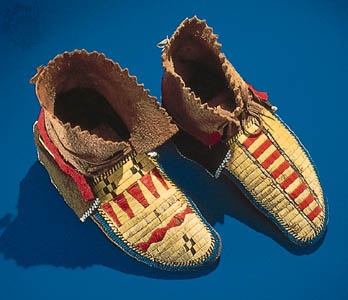 The origins of most Native American decorative designs cannot be traced accurately today; most of them are lost in antiquity. Many obviously came from natural forms, while others are simple developments of geometric or lineal motifs. Some have become so interwoven with alien concepts—Western, after the advent of the European, for example—that it is impossible to completely unravel their sources. There is evidence, however, that some of the original forms were creations of individual artists and were often the result of a vision quest. To the Indian, the world of the vision quest is mysterious, a place where the soul can leave the body, participate in many strange activities, and see many unusual sights. Since many of the designs seen or creatures encountered during the vision quest are regarded as protective forms or spirit-beings, these would be carefully re-created during waking hours. Non-artists would occasionally describe their dream creatures to a designated artist so that they could be recorded on hide, in wood, or in stone. But since these supernatural visions were extremely personal, they were usually recorded by the individual himself; hence, they vary tremendously in aesthetic quality.
The origins of most Native American decorative designs cannot be traced accurately today; most of them are lost in antiquity. Many obviously came from natural forms, while others are simple developments of geometric or lineal motifs. Some have become so interwoven with alien concepts—Western, after the advent of the European, for example—that it is impossible to completely unravel their sources. There is evidence, however, that some of the original forms were creations of individual artists and were often the result of a vision quest. To the Indian, the world of the vision quest is mysterious, a place where the soul can leave the body, participate in many strange activities, and see many unusual sights. Since many of the designs seen or creatures encountered during the vision quest are regarded as protective forms or spirit-beings, these would be carefully re-created during waking hours. Non-artists would occasionally describe their dream creatures to a designated artist so that they could be recorded on hide, in wood, or in stone. But since these supernatural visions were extremely personal, they were usually recorded by the individual himself; hence, they vary tremendously in aesthetic quality.Because art designs were regarded as personal property, an artist could buy a design or receive it as a gift from its creator, but to appropriate and use it for his own purposes was taboo.
The function of art
Many Indian art objects are basically intended to perform a service—for example, to act as a container or to provide a means of worship. The particular utilitarian form that Native American arts take often reflects the social organization of the cultures involved. Political and military societies seem to have found their major art forms in the world of weaponry, regalia, and panoply. This is most pronounced in the Plains (Plains Indian), Aztec, and Inca civilizations, all of which reflect the dominant warrior culture in their arts. Those cultures in which life was heavily governed by religion tended toward a greater degree of ceremonial art than those in which life was less ritualized. All of the aesthetic expressions that have come down from the Maya, for example, obviously reflect the considerable weight of theocracy that existed in their world.
Generally, but not necessarily, the best of Indian artwork was applied to those objects intended to please a deity, soothe the angry gods, placate or frighten the evil spirits, and honour the newly born or recently deceased. Through such means, Native Americans sought to control the environment and the human or supernatural beings that surrounded or threatened them.
Some specific articles were reserved solely for religious uses, and some were for secular needs alone. Decoration does not always provide a clue as to these uses. Some of the most highly revered religious articles are completely devoid of ornamentation—in fact, they may be rather ugly—while others are highly embellished. Some peoples used plainware bowls for food preparation, while others used polychrome bowls for the same purpose. Many objects served a dual function: normally, they were used for everyday household purposes, yet under a different set of circumstances they could fulfill a religious function. Beneath the surface, there was a magic at work, and, in initiated hands, a mundane article might release its supernatural power, calling upon unseen forces to aid its owner. This power might be visually evident in the form, shape, or decoration of the object or might simply be believed in no matter what the physical state or appearance of the object might be. A Crow warrior's rawhide shield, for example, might be embellished with a symbolic drawing, as well as with such materials as sacred eagle feathers and a crane's head, in order to imbue him with such qualities as invulnerability and supernatural swiftness and strength.
The aim of the Indian artist was not merely to set down realistic records but to create the semi-magical designs so common in the art of non-Western cultures. He quickly realized that he could not draw a tree as perfectly as it could be made by the Creator; so, with common sense, he did not try. Instead, he sought the spirit or essence of the tree and represented this in his design. Carvings, paintings, effigies, or realistic portraits are not simply pictures of people or objects; they embody the essence of that particular subject as well. This semi-magical character of Native American art is difficult for the Western mind to understand. Not infrequently, the non-Indian will ask, “What does that design mean?” Native Americans often attach names to designs, largely for convenience. Viewers may be confused when an Indian calls a given design a “leaf,” or an “arrowhead,” when what he actually means is that the design is “leaflike,” or “leaf-shaped,” and so on. But the non-Indian immediately translates this to mean that the design signifies a leaf or an arrowhead and tries to impart a narrative to the overall visual concept that is not relevant to the original artist's work.
ritual was often interwoven into the very process of creating Indian art. Western assessment of Native American art often centres on the product rather than the process; Indian artists, however, give exacting attention to the creative process and interact with their materials at all stages of creation. The Iroquois False Face mask, for example, must be carved from the trunk of a living tree—hence the term live mask. The tree is ritually addressed before the carver begins, and the mask and the tree are “fed” tobacco before the two are separated. Such prescribed ritual is of equal, if not more, importance than the artistic skill employed in the production of the work. If the ceremonial acts were ignored, the article would lose its efficacy—and might even prove dangerously counteractive. This ritual aspect, which permeates most of the ceremonial paraphernalia, is extremely complex and must be considered throughout the creation of the work of art.
Not all Indian art, however, was religious or political. There was also a considerable amount of mundane, humorous, and even profane art produced by most cultures. Although much of the eroticism has disappeared in the Puritan fires that continue to burn the Westerner, sufficient examples remain from prehistoric and recent times to indicate a wholly relaxed freedom of expression reflecting a healthy, naturalistic outlook.
Materials
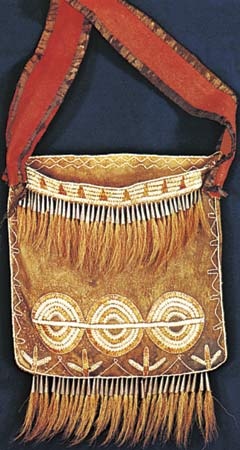 Working in the materials natural to their respective homelands, the various Native American cultures produced art that reflected their environment. Those peoples living in heavily forested regions, for example, inevitably became gifted sculptors in wood; those for whom clay was a major resource became skillful potters; and those living in the grasslands became fine basket weavers. There is virtually no natural medium that has not been explored and mastered by the Indian: jade, turquoise, shell, metals, stone, milkweed fibre, birch bark, porcupine quills, deer hair, llama dung, sea lion whiskers—all were used by the artist to lend colour or texture to the finished product. In many instances, such materials became desired commodities in themselves, to be traded over great distances; for certain objects were not regarded as “official” unless they were manufactured from a prescribed material, and, especially for religious purposes, a substitute could not be tolerated. Often, in such cases, the materials achieved a standard value within the economy, with ready acceptance as a medium of exchange wherever they were in vogue.
Working in the materials natural to their respective homelands, the various Native American cultures produced art that reflected their environment. Those peoples living in heavily forested regions, for example, inevitably became gifted sculptors in wood; those for whom clay was a major resource became skillful potters; and those living in the grasslands became fine basket weavers. There is virtually no natural medium that has not been explored and mastered by the Indian: jade, turquoise, shell, metals, stone, milkweed fibre, birch bark, porcupine quills, deer hair, llama dung, sea lion whiskers—all were used by the artist to lend colour or texture to the finished product. In many instances, such materials became desired commodities in themselves, to be traded over great distances; for certain objects were not regarded as “official” unless they were manufactured from a prescribed material, and, especially for religious purposes, a substitute could not be tolerated. Often, in such cases, the materials achieved a standard value within the economy, with ready acceptance as a medium of exchange wherever they were in vogue. The relationship between material and design in Indian art was quite different from that in the Western tradition. The Western painter usually imposed a design on the artificially limited surface of a flat, rectangular canvas; and the sculptor, following predetermined spatial arrangements, imposed a shape on his material. On the other hand, the Indian painter and sculptor were less likely to force their materials to conform to a preconceived design. They tended instead to adapt their design to the natural outlines of their materials, which often happened to be a complete and therefore irregular buffalo hide, a tree branch, or a stone. This naturalism is one of the most pleasing aspects of Indian art and often demonstrates the artist's remarkable ability to incorporate the natural form into his composition.
The relationship between material and design in Indian art was quite different from that in the Western tradition. The Western painter usually imposed a design on the artificially limited surface of a flat, rectangular canvas; and the sculptor, following predetermined spatial arrangements, imposed a shape on his material. On the other hand, the Indian painter and sculptor were less likely to force their materials to conform to a preconceived design. They tended instead to adapt their design to the natural outlines of their materials, which often happened to be a complete and therefore irregular buffalo hide, a tree branch, or a stone. This naturalism is one of the most pleasing aspects of Indian art and often demonstrates the artist's remarkable ability to incorporate the natural form into his composition.Regional styles of American Indian visual arts
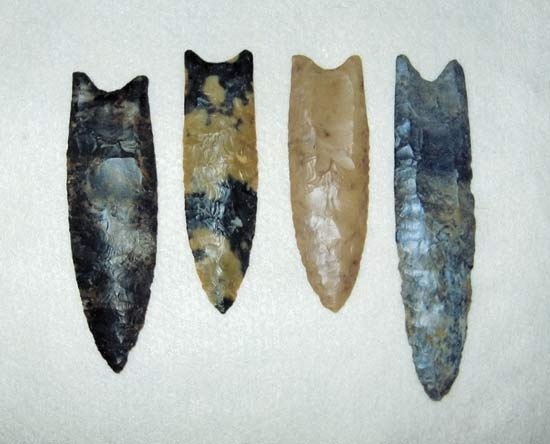 The term Native American art covers an extremely broad category, encompassing all art expressions of the original inhabitants of the Americas and their cognate descendants. It thus includes not only varied and completely disparate cultures but also spans great time sequences—from the early 21st century back to prehistoric times. (Surviving artifacts clearly demonstrate that ancient man was already possessed of considerable aesthetic ability; flint, for example, was carefully flaked into attractive, well-balanced forms, and stone carving and pottery were capably handled.)
The term Native American art covers an extremely broad category, encompassing all art expressions of the original inhabitants of the Americas and their cognate descendants. It thus includes not only varied and completely disparate cultures but also spans great time sequences—from the early 21st century back to prehistoric times. (Surviving artifacts clearly demonstrate that ancient man was already possessed of considerable aesthetic ability; flint, for example, was carefully flaked into attractive, well-balanced forms, and stone carving and pottery were capably handled.)Although the dissimilarities between the artistic expressions of different cultures and different times are great, there are also similarities; for the borrowing of art forms from distant and occasionally alien peoples was a common practice. Objects in museum collections reveal, for example, that ornamental materials such as feathers, shells, jade, and turquoise were traded or transported thousands of miles. This far-flung trade expanded the limits of tribal styles, for new ideas were diffused as well as materials. In time, new designs and motifs became part of the stylistic concepts and traditions of people to whom they had been introduced. Intertribal marriage, too, affected regional styles. While in some tribes marriage within the group was required, in others it was forbidden. In the latter case, artistic traditions could spread to the new group, into which they were subsequently incorporated.
It is becoming increasingly evident that there were common forces at work in the art of various groups, even if widespread in time and space. There are certain symbols that are widely encountered, and some would seem to have had similar significance over a wide area. It is likely that trade routes or political hegemony levied the major influences upon this phenomenon. In Middle America, for example, the so-called Plumed Serpent (Quetzalcóatl) motif is to be found in one form or another in almost every culture, and this motif extends even into the United States, where it is encountered in visual form as well as in legend. The existence of the feline deity virtually throughout South America, from the south up into the northern Andean region, is another instance of the travel of an idea and a visual element. Certain customs also have enjoyed wide acceptance; for example, the role of trophy heads, the use of masked personations, and winter solstice New Fire ceremonies. And each of these customs was accompanied by related visual art expressions.
Despite the similarities between the art forms of different cultural groups and different times, one cannot speak of Indian art as though it were a single concept. Just as there were several hundred native languages, dialects, and speech forms, so were there an equal number of tribal styles, motifs, and design forms. In trying to establish a common aesthetic bond, the well-schooled researcher generally finds as many differences as he does similarities.
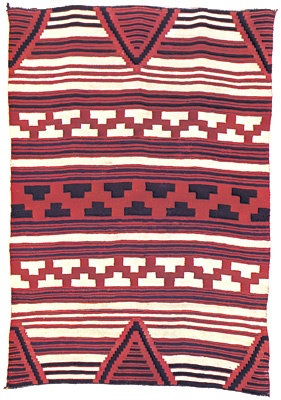 When two completely different peoples move into a common area, such as occurred with the migration of the Athabaskan Navajo into the Pueblo (Pueblo Indians) Southwest, the eventual result may be a melding of cultures, the loss of certain ancient individualities—since each contributes to the new expression—and the emergence of new aesthetic qualities. It is not certain just how skilled the Navajo weavers (Navajo weaving) were when they arrived in the Southwest, but the Pueblo people were highly developed in that art. Subsequently, the Navajo not only learned new weaving techniques and designs but in time also improved upon the acquired Pueblo methods, transferred the gender role of the weaver from male to female, and matured as far more sophisticated artisans. On the other hand, under the same circumstances, surprising differences can sometimes be found; for example, while the Hopi and Zuni people live almost side by side and under similar cultural conditions, it is quite possible to identify the art products of both groups without great difficulty. This is equally true of cultures in ancient times, such as the Aztec and Mayan or, in another time and another region, the Sioux and the Crow.
When two completely different peoples move into a common area, such as occurred with the migration of the Athabaskan Navajo into the Pueblo (Pueblo Indians) Southwest, the eventual result may be a melding of cultures, the loss of certain ancient individualities—since each contributes to the new expression—and the emergence of new aesthetic qualities. It is not certain just how skilled the Navajo weavers (Navajo weaving) were when they arrived in the Southwest, but the Pueblo people were highly developed in that art. Subsequently, the Navajo not only learned new weaving techniques and designs but in time also improved upon the acquired Pueblo methods, transferred the gender role of the weaver from male to female, and matured as far more sophisticated artisans. On the other hand, under the same circumstances, surprising differences can sometimes be found; for example, while the Hopi and Zuni people live almost side by side and under similar cultural conditions, it is quite possible to identify the art products of both groups without great difficulty. This is equally true of cultures in ancient times, such as the Aztec and Mayan or, in another time and another region, the Sioux and the Crow.It is in those tribes or cultural entities that at one time were part of a whole but have subsequently split off that one most often finds common themes, art elements, and cultural patterns so similar as to be confusing.
To most readily understand some of the artistic impulses active among the tribes of the New World, it is convenient to take them in geographical sequence, from North America to South America.
Regional style: North America (Native American)
The aesthetic products of North American prehistory are perhaps the least well known to the non-Indian public. This is partly because these early people left few spectacular architectural ruins as compared with their Latin American cousins. This is not to say that architectural monuments did not exist. Spanish accounts report that great temple mounds were in use in the Southeast at the time of the first European entry, in the mid-16th century. But most of these structures were of perishable wood and have long since disappeared—as have most examples of the great use of colour and the tremendous range of textiles. So many materials were perishable that scholars have little by which to judge their arts and must, in effect, draw conclusions about a people by only a small proportion of their achievement.
Southwest (Southwest Indian)
 In the Southwest, the monumental stone cliff dwellings that remain are eloquent testimony to the culture that existed there. Progressing from a simple pit house through aboveground homes, these people moved out onto the plateau regions of what are now Arizona and New Mexico and built remarkable multistoried structures (pueblo architecture), some—such as Pueblo Bonito in New Mexico—sheltering hundreds of families (Pueblo Indians) in more than 400 rooms.
In the Southwest, the monumental stone cliff dwellings that remain are eloquent testimony to the culture that existed there. Progressing from a simple pit house through aboveground homes, these people moved out onto the plateau regions of what are now Arizona and New Mexico and built remarkable multistoried structures (pueblo architecture), some—such as Pueblo Bonito in New Mexico—sheltering hundreds of families (Pueblo Indians) in more than 400 rooms.These apartment houses were well suited for the demands of their environment; their walls were of stone or clay and sand mixed as an adobe. The thick stone walls provided excellent insulation, being warm in winter and cool in summer. Heights reached to seven stories, although most villages were of three or four levels.
Major divisions of these early Southwestern Indians include the Hohokam (Hohokam culture) of southern Arizona, the Ancestral Pueblo (Ancestral Pueblo culture) (Anasazi) of northern Arizona–New Mexico, and the Mogollon (Mogollon culture) of southwestern New Mexico. In addition to these groups—each of which produced a style of its own, distinct from all others—were dozens of lesser subgroups that archaeologists have been studying for decades in an effort to assemble the pieces of this giant jigsaw puzzle.
The people living in the pueblos produced some of the most successful artwork. They were masters of weaving, painting, and particularly of pottery making. Their weaving techniques long antedated the arrival of Spanish sheep; a native cotton provided ample fibre for intricate weaves coloured with native dyes. Mineral and vegetable pigments provided colourful decorations when applied with a fibre brush to wood or clay or to white-plastered walls in a fresco technique. Fortunately, abundant kaolin deposits yielded high-quality clay for the creation of excellent pottery forms. Although small stone effigies have been found, sculpture was not a highly developed art form. Pueblo art is essentially linear or geometric in design and reveals a preference for applied decoration. The large underground kivas (kiva) (rooms used for religious purposes) were decorated with murals executed in brilliant mineral-pigment colours.
Pueblo art became a strongly conventionalized art, held to relatively rigid forms. This characteristic was determined, no doubt, by the closely knit communal nature of a culture that depended upon close cooperation for survival. At its best, early Southwestern art is marked by technical competence and fine control of line and form; but it reflected little experimentation, tending more to rework established patterns in many intricate designs.
In the Southwest the arts flourished and are still active forces in the lives of the peoples who practice them. Almost all of the crafts practiced in prehistoric times are still practiced today, along with some newly introduced expressions. The early trade routes brought new ideas to the Pueblos, encouraging the development of new creations and the strengthening of new markets. Yet, because of its essential conservatism, Pueblo art, like the culture in which it thrives, remains closely related to its ancient antecedents.
Along the same trade routes came invading tribes from other regions, particularly the Navajo and Apache, who subsequently settled in the Southwest and in time surpassed their teachers in certain arts that they adopted, improved upon, and made their own—notably, silversmithing (silverwork) and weaving. Whereas Pueblo weavers once dominated the textile field, the work of the remarkably inventive Navajo weavers became highly sought after in the late 20th century. Silversmithing, another famed Navajo art, is more recent; it was only in 1853 that the first Navajo smith took up the tools of his craft, but within the next century Navajo jewelry and ornaments acquired a wide appreciation.
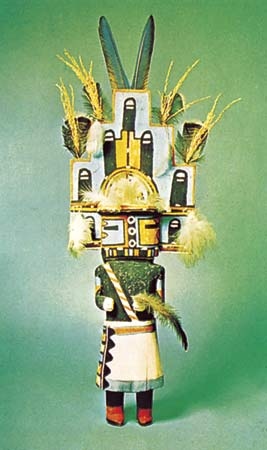 As in the prehistoric era, Southwestern sculpture has failed to develop as a major art form. The most active sculptural work in the Southwest is reflected in the carved and painted cottonwood kachina (katsina) dolls (see kachina) of the Hopi and Zuni, which have enjoyed wide popularity as collectors' items. Many variations of these wood carvings are also found in altar and shrine figurines, which are not produced for commercial consumption.
As in the prehistoric era, Southwestern sculpture has failed to develop as a major art form. The most active sculptural work in the Southwest is reflected in the carved and painted cottonwood kachina (katsina) dolls (see kachina) of the Hopi and Zuni, which have enjoyed wide popularity as collectors' items. Many variations of these wood carvings are also found in altar and shrine figurines, which are not produced for commercial consumption.The crafts (decorative art) of basketry and pottery are moderately active. But very little pottery is made for native use; it is largely intended for the outside market. Although both pottery and basketry are produced in much smaller quantities than they were after first European contact, the quality of contemporary work is consistently high.
Specialization has long been a factor in Southwestern art and has become increasingly so in recent years. Certain tribes produce almost all of the small carved fetishes, or tiny drilled shell and stone beads. The Zuni favour intricately worked silver jewelry with tiny turquoise settings, while the Navajo make use of massive silver castings with heavy turquoise sets. The Navajo also make most of the heavy rugs and textiles, while the Hopi supply lightweight ceremonial kilts, sashes, and similar costume fabrics.
Another art form that may have been brought from the north, but that was more likely adopted from Pueblo culture, is sand painting (more accurately termed dry painting). The use of a variety of finely ground mineral pigments, which are allowed to trickle through the fingers to form a variety of complicated patterns, has become uniquely Navajo. These designs provide a focus for curing ceremonies.
Midwest and Great Plains
The existence of rich textile art in the prehistoric Middle West is known, but its range and development are lost in hundreds of years of history from which few examples survive. Examples of basketry and wood are similarly rare. Enough of these perishable items have survived to indicate that these arts had been mastered, but not enough examples remain to enable scholars to judge their aesthetic development. What has survived in profusion is stone, worked skillfully and in many ways. Pottery, too, though not of highest quality, and copper and mica ornaments have been found.
Of the relatively perishable substances, finely carved and incised shell is common, which, along with bone, indicates the artistic range of these early peoples. The quantity of objects found is impressive. Numerically significant groups, the peoples of the region were active in the production of materials and implements with which to meet the challenge of their environment. Scholars cannot determine the function of all the recovered examples of stonework, but it is known that much of the archaeological wealth was ceremonial in nature, indicating a highly organized civilization.
Ritual structures existed, such as the so-called effigy mounds (effigy mound)—great piles of earth fashioned to represent a variety of animals (animal). The Serpent Mound in Ohio is an example of this custom. Truncated pyramids served as large bases for wooden temples, now long vanished but still in use when Spanish explorers first entered the region. Monks Mound, dominating the Cahokia Mounds, near Collinsville, Ill., is the largest prehistoric earthen construction in the New World.
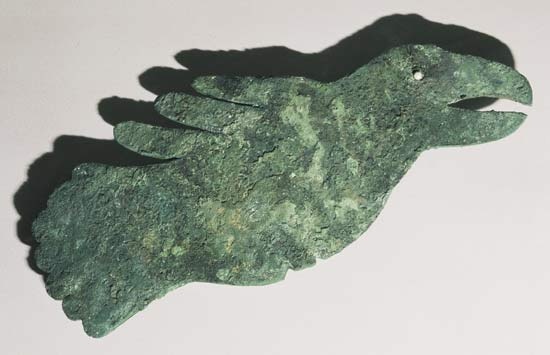 Major cultural expressions from this region included those of the Adena (Adena culture), Hopewell (Hopewell culture), Oneota, and Old Copper culture peoples; their art was extensive, making great use of sculptured stone pipes, polished ornaments of both stone and copper, and incised shell decorations.
Major cultural expressions from this region included those of the Adena (Adena culture), Hopewell (Hopewell culture), Oneota, and Old Copper culture peoples; their art was extensive, making great use of sculptured stone pipes, polished ornaments of both stone and copper, and incised shell decorations.The later Great Plains region is the area most familiar to the average non-Indian, for this is the world of the Buffalo Bill shows, television and movie programs, and fiction. From it came the buckskin and beadwork costumes, feathered warbonnets, colourful porcupine quill decoration, and painted shields that personify the American Indian in the minds of most people.
Yet, there was no monolithic culture. The arts of the Plains Indian varied considerably from tribe to tribe; some peoples seem to have had superior aesthetic taste, demonstrated by their sensitive and inventive developments in the arts.
Very little woodcarving was produced here in proportion to the other arts, yet a respectable body of wooden bowls, clubs, effigies, figurines, and similar objects indicates that the Plains artist did not ignore this medium. Even less pottery and basketry was produced, for containers were primarily made from buffalo hide.
A great deal of Plains art served both decorative and spiritual ends. A given design might appear to be primarily a colourful decoration, yet to the initiated it was also the guardian spirit of the owner.
Colour was originally achieved by mineral pigments or vegetable dyes. In time, these were supplanted by commercial dyes and trade colours. Porcupine quilling—the use of small quills (quillwork) of the North American porcupine (Erethizon dorsatum), which are flattened, dyed, and then applied to the surface of animal hides or textile materials—is an art produced nowhere else in the world. For a time quillwork was replaced by the use of glass trade beads (beadwork), which were not only technically similar in their application to quillwork but did not fade and gave a richness of colour unobtainable in any other way. But in the late 20th century, the art of quillwork experienced a resurgence.
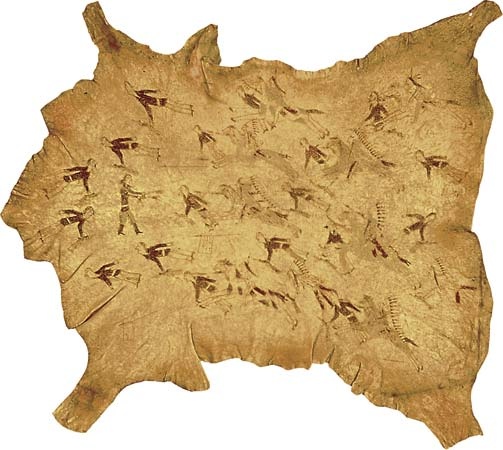 The art forms themselves range from realistic to extremely abstract and symbolic. Often they are narrative in content, as with the Winter Counts, those painted records that recounted tribal history by means of annual symbols, and the personal history paintings on hide that recount the exploits of the owner.
The art forms themselves range from realistic to extremely abstract and symbolic. Often they are narrative in content, as with the Winter Counts, those painted records that recounted tribal history by means of annual symbols, and the personal history paintings on hide that recount the exploits of the owner.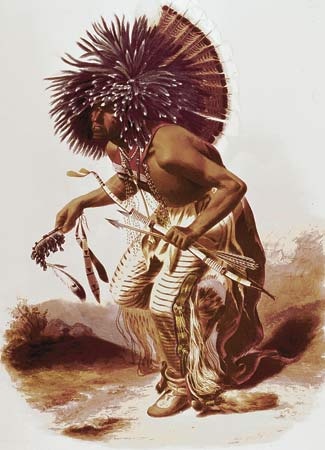 Not only did the Plains Indian decorate his home but also his person, with carefully coiffured hair, facial painting, and clothing enhancement. And he devoted the same aesthetic attention to his horse as he did to himself, creating beautifully decorated gear for special occasions. Statically displayed in a museum exhibit, much of this ornamentation loses the grace of motion. When worn as intended, the motion of the wearer and the wafting of the Plains breeze gave the feathered regalia or the fringed buckskin a lively grace and colour.
Not only did the Plains Indian decorate his home but also his person, with carefully coiffured hair, facial painting, and clothing enhancement. And he devoted the same aesthetic attention to his horse as he did to himself, creating beautifully decorated gear for special occasions. Statically displayed in a museum exhibit, much of this ornamentation loses the grace of motion. When worn as intended, the motion of the wearer and the wafting of the Plains breeze gave the feathered regalia or the fringed buckskin a lively grace and colour.Far West, Northeast, Central South, and Southeast
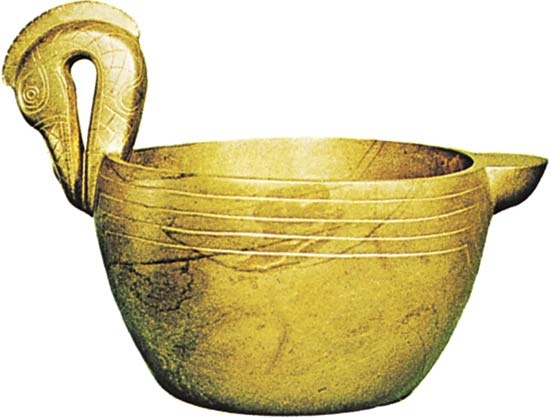 In prehistoric times, the central south and southeast were part of the most artistically exciting region of the North American continent. This land of temples, mounds, and monuments was an amazing world, and one can truly understand the legends that grew up around the riches that were evident when the Spanish arrived and that are still found in archaeological excavations. Testifying to the highly developed civilizations that existed are the beautifully carved shells, incised gorgets, and intricately decorated clothing ornaments; the carved stone effigies of ancestor figures or deities, which suggest a strong affinity with ancient Mexico; and the many bird and animal pipes in museums throughout the country. Had the Middle Mississippian culture diorite bowl found at Moundville, Ala., been the only masterpiece to survive, however, no other proof of the artistic brilliance of these peoples would be required.
In prehistoric times, the central south and southeast were part of the most artistically exciting region of the North American continent. This land of temples, mounds, and monuments was an amazing world, and one can truly understand the legends that grew up around the riches that were evident when the Spanish arrived and that are still found in archaeological excavations. Testifying to the highly developed civilizations that existed are the beautifully carved shells, incised gorgets, and intricately decorated clothing ornaments; the carved stone effigies of ancestor figures or deities, which suggest a strong affinity with ancient Mexico; and the many bird and animal pipes in museums throughout the country. Had the Middle Mississippian culture diorite bowl found at Moundville, Ala., been the only masterpiece to survive, however, no other proof of the artistic brilliance of these peoples would be required.Wood was used in profusion, although little of it has been preserved in anything resembling its original condition. A quantity of textiles, albeit in fragments, has also survived. Other perishables include decorative freshwater pearls, featherwork, bone, and animal hides.
But it is in the claywork that the greatest vitality seems to have been expressed. While much of the clay used was of inferior quality, the results were astonishing. Exuberant forms, delicately traced surface lines, and strong, powerful designs were all executed with a confidence and grace that still attracts contemporary art students. A tremendous assortment of vessel designs was created in the Southeast: floral, geometric, clay appliqué, delicate polished water bottles and huge burial jars, as well as many lovely vessels created to hallow a shrine, decorate a temple, or do homage to a god—all providing evidence of the imagination, skill, and sheer love of clay for its own sake that these early potters must have felt. Enough of the remarkably large output has survived to give an excellent idea of the aesthetic heights that were attained.
With the coming of European settlers, this creativity was ended or diverted. Tribes were killed off or dispersed by battle, disease, and slavery, or their social organization was so disrupted that normal pursuits were destroyed and their energies were spent on survival. While the introduction of new and better tools allowed greater technical proficiency, the economic stability that had formerly allowed time to express a strong creative impetus was no longer present. Artists had lost their old markets—purchasers who understood what they were buying—and instead served a customer more concerned with external appearance than with the function of the object. The result was what is disparagingly known as tourist art—ostentatious elaboration that had little to do with the integrity of the product.
Today almost all of the aboriginal arts of the Southeast have been lost or are much less actively pursued. The great stone sculpture for which it was so famous has entirely disappeared, although excellent wood sculpture is a continuing art; pottery is quite different from the earlier styles. The most active art, and probably the most successful, is basketry, in which the present-day artists are in every way equal to, or better than, their predecessors.
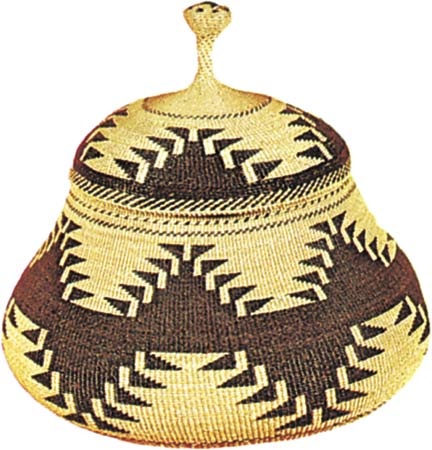
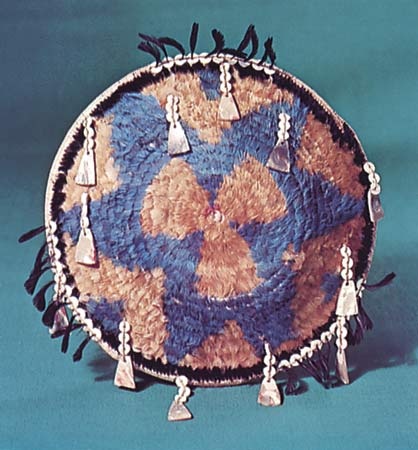 The great art of the California Indians (California Indian) was basketry; no other people in the world has produced such a wide variety of superb basketry. The Pomo, Hupa, Yurok, and Karok peoples of the north developed basketry to its ultimate with weaves so tightly composed as to provide a watertight container, baskets so small that they measure less than one-eighth inch (three millimetres) in diameter, huge grain-storage baskets, and delicately woven “gift” baskets with the feathers of birds interwoven that provided not only an opportunity for the weaver to demonstrate her mastery of the art but also a means whereby she could display her affection for the deceased. Elsewhere the Chumash, Mono-Paviosto, Washoe, and Panamint proved no less skilled.
The great art of the California Indians (California Indian) was basketry; no other people in the world has produced such a wide variety of superb basketry. The Pomo, Hupa, Yurok, and Karok peoples of the north developed basketry to its ultimate with weaves so tightly composed as to provide a watertight container, baskets so small that they measure less than one-eighth inch (three millimetres) in diameter, huge grain-storage baskets, and delicately woven “gift” baskets with the feathers of birds interwoven that provided not only an opportunity for the weaver to demonstrate her mastery of the art but also a means whereby she could display her affection for the deceased. Elsewhere the Chumash, Mono-Paviosto, Washoe, and Panamint proved no less skilled.The Eastern Woodlands tribes (Northeast Indian) fall into three divisions: the Southeast (discussed above (Native American art)) and the Great Lakes and Northeast. The Great Lakes group produced various arts, including woodwork, a style of weaving with rush and hemp, and a strong porcupine quill art (quillwork), later replaced by beadwork. This style of beadwork was popular around the turn of the 19th century, when large quantities of it became available. The art depended upon a weaving frame, which allowed the manufacture of long strips, useful for necklaces, belts, panels, and headbands. Fabric, especially ribbon, appliqué is an important art in the Great Lakes region. Wood art made effective use of burls (hemispherical outgrowths on a tree), from which bowls and containers were fashioned. Pottery was almost nonexistent.
The people of the Northeast (Algonquin), notably the Iroquois, are famous for their False Face Society masks, quillwork and beadwork, wooden bowls and ladles, and the woven wampum belts, which are important historical documents. Some pottery was produced, but not of significant quantity or quality. Woodlands basketry was common, but it was not of the quality found elsewhere. Primarily a splint-weave type, it was rarely ornamented, and when it was, the ornament consisted of stamped or painted vegetable-dye designs.
Eskimo (Inuit) and Northwest Coast
Eskimo (Inuit)
It may seem unlikely that art would occupy very much of the attention of the inhabitants of the bleak Arctic regions; not only is there little raw material to work with, but the ever-present need to secure a food supply would seem to leave little time for craftwork. Yet, from this harsh environment came some of the most imaginative and humorous of Indian carvings. During the long winter nights, the Eskimo had ample time to work the ivory that came from the walrus and whale.
 Art styles of the area favoured carving in the round, decoration by incising, and a modest amount of inlay. Since the basic material was often a tusk or a tooth, these objects partially dictated the form, which was embellished after carving by incising or engraving. Black pigment, from charcoal fires, was rubbed into the lines for emphasis. Such prehistoric wood carving as may have existed has almost entirely disappeared, but enough has survived to indicate that it was a rich and varied art form. Ancient ivory carvings have also been excavated, revealing a sophisticated, formal style. The so-called fossil ivory from which these carvings were made is highly prized even today and, when found, is invariably turned into beautiful carvings that gain value because of the scarce, richly colourful raw material.
Art styles of the area favoured carving in the round, decoration by incising, and a modest amount of inlay. Since the basic material was often a tusk or a tooth, these objects partially dictated the form, which was embellished after carving by incising or engraving. Black pigment, from charcoal fires, was rubbed into the lines for emphasis. Such prehistoric wood carving as may have existed has almost entirely disappeared, but enough has survived to indicate that it was a rich and varied art form. Ancient ivory carvings have also been excavated, revealing a sophisticated, formal style. The so-called fossil ivory from which these carvings were made is highly prized even today and, when found, is invariably turned into beautiful carvings that gain value because of the scarce, richly colourful raw material.A predominant characteristic of Eskimo art is the warm sense of humour that is so prevalent. Sometimes it is expressed in caricature, sometimes in sequential “cartoon strip” form. Its surrealistic expression is probably a reflection of the Eskimo's awareness that, because life in the Arctic is so tenuous, humour is vital to psychological health.
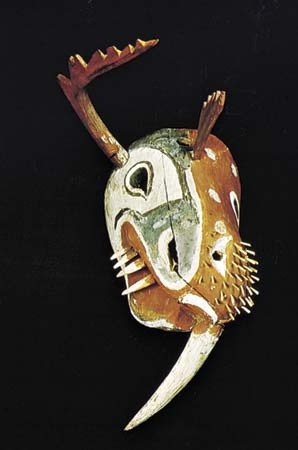 Another significant feature of the art of this region is the remarkable mechanical skill that was often involved in the creative process. Part of the Eskimo's artistry was his ability to neatly piece together small parts to create a whole—and his ability to fashion the tools needed to carry out the operation, many of which were works of art themselves. This skill is evident in the region's most famous art form: the fantastic wooden masks used for various dances and social affairs. While many tribes made wooden masks and decorated them with colourful ingenuity, no North American aboriginal people developed the art of imaginative characterization to such an extreme. Surrealism par excellence. These masks demonstrate a combination of realistic, imaginative, and supernatural qualities that is uniquely Eskimo.
Another significant feature of the art of this region is the remarkable mechanical skill that was often involved in the creative process. Part of the Eskimo's artistry was his ability to neatly piece together small parts to create a whole—and his ability to fashion the tools needed to carry out the operation, many of which were works of art themselves. This skill is evident in the region's most famous art form: the fantastic wooden masks used for various dances and social affairs. While many tribes made wooden masks and decorated them with colourful ingenuity, no North American aboriginal people developed the art of imaginative characterization to such an extreme. Surrealism par excellence. These masks demonstrate a combination of realistic, imaginative, and supernatural qualities that is uniquely Eskimo. Since about 1950, a stone art form, utilizing deposits of gray and green soapstone, or steatite, found in the vicinity of Hudson Bay, has become familiar to art collectors. Usually given an artificial colouring, these pieces of small-scale sculpture are popular examples of genre art. They reflect the inherent sculptural skills of the Eskimo and owe their origin and promotion to non-Indian agencies that have worked closely with several of the crafts groups in the region. A form of graphic art derived from Japanese printmaking techniques has also become popular in this way.
Since about 1950, a stone art form, utilizing deposits of gray and green soapstone, or steatite, found in the vicinity of Hudson Bay, has become familiar to art collectors. Usually given an artificial colouring, these pieces of small-scale sculpture are popular examples of genre art. They reflect the inherent sculptural skills of the Eskimo and owe their origin and promotion to non-Indian agencies that have worked closely with several of the crafts groups in the region. A form of graphic art derived from Japanese printmaking techniques has also become popular in this way.Northwest Coast (Northwest Coast Indian)
It was in this region, richly endowed with tremendous cedar and spruce forests, that the Native American sculptor achieved his finest expression. It is probably here that the influence of tools upon the artist is best exemplified; for, with the introduction of steel cutting knives, the Northwest Coast artist was free to demonstrate his talent in the aesthetically superb sculpture that is rivalled by no other Indian people in North America.
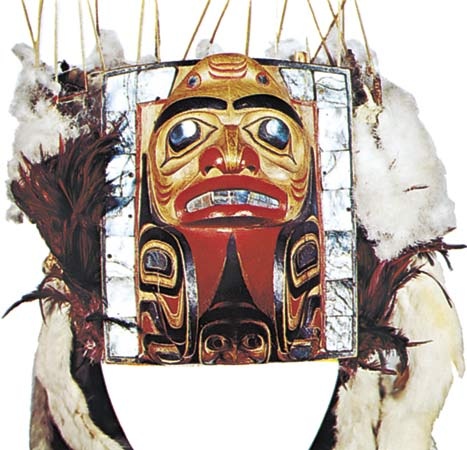 Tall, straight cedar poles furnished the material for the huge memorial, or totem, poles (totem pole), the smaller wooden figures, the masks, and the other carved objects so loved by the Northwest Coast Indian. Inlaid with abalone Haliotis shell and carefully painted, these products took on a quality so distinctive that they are immediately identifiable.
Tall, straight cedar poles furnished the material for the huge memorial, or totem, poles (totem pole), the smaller wooden figures, the masks, and the other carved objects so loved by the Northwest Coast Indian. Inlaid with abalone Haliotis shell and carefully painted, these products took on a quality so distinctive that they are immediately identifiable.Another remarkable quality of the Northwest Coast artist is his skill and interest in fitting designs into forms. He excels at fitting his designs into a given area, shape, or prescribed form, yet without sacrificing the integrity of the design.
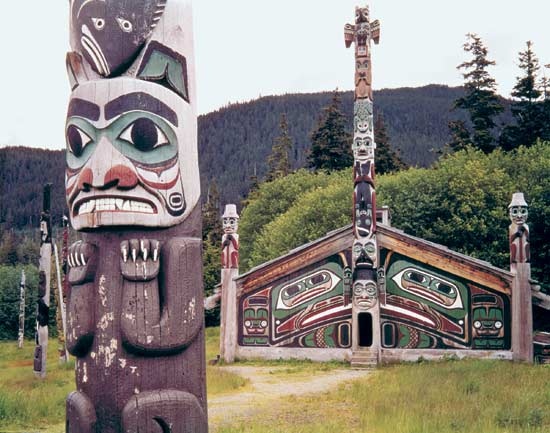 The role of the tall totem poles from this area has not been well understood by non-Indians, and many erroneous accounts have been published as to their purpose and meaning. They were not religious and were never intended to be worshipped. They were instead memorial documents, recording the social position, wealth, and relative importance of the person who had paid for the pole. Because family lineage, class status, wealth, and other social facts were thus recorded, it was possible to gain an “introduction” to the village chief or house owner by simply examining the tall pole.
The role of the tall totem poles from this area has not been well understood by non-Indians, and many erroneous accounts have been published as to their purpose and meaning. They were not religious and were never intended to be worshipped. They were instead memorial documents, recording the social position, wealth, and relative importance of the person who had paid for the pole. Because family lineage, class status, wealth, and other social facts were thus recorded, it was possible to gain an “introduction” to the village chief or house owner by simply examining the tall pole.The goal of most of this rich art was the exaltation of the individual—more specifically, a wealthy village chief or a great noble, for the society was based on a class system. Part of the insignia of social position was the accumulation of wealth, and objets d'art were an important part of that wealth. With the coming of the Euro-Americans, who coveted the rich furs of the region, the control of the great fishing areas and strategic position of the Northwest Coast tribes enabled them to acquire staggering wealth in an extremely brief space of time. The existence of an Indian purchasing class, with its ever-increasing need for impressive possessions, created a supplier: the professional artist. This was thus one of the very few aboriginal cultures outside Mexico that gave rise to art patrons who hired artists on a commission basis.
More surprising, the works that were commissioned were usually destined to be given away. While this may seem paradoxical, the logic was simple: the more one gave away, the greater one's prestige (see potlatch).
The Northwest Coast tribes were among the first American Indians to master metalcraft (metalwork). While some copper came from local sources, most came from whaling ships, both as cargo brought in for trade and as scrap peeled from the hulls of wrecked ships. This metal was worked with great skill by Tlingit and Haida artists into fighting knives, masks, overlays for artworks, and the great shield-shaped tinneh that were so highly prized.
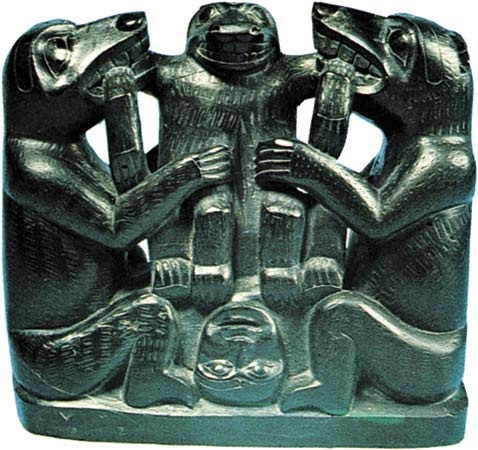 Among the Northwest Coast tribes, the Tlingit people of Alaska seem to have produced the most sensitive and sophisticated sculpture. The Kwakiutl, on the other hand, expressed their feeling for line and form in extremely impressive and powerful painted carvings: the designs are usually outlined in strong colours; there is far less subtlety of form; and the overall feeling is of a potent force at work. Between the two extremes are the Haida carvers, whose work, often less strongly painted than Kwakiutl work, is marked by precision of design, skill in execution, and strength of expression. These are the people who were responsible for the familiar black “slate carvings,” which are actually made of argillite, a stone found locally only on Queen Charlotte Islands, in British Columbia.
Among the Northwest Coast tribes, the Tlingit people of Alaska seem to have produced the most sensitive and sophisticated sculpture. The Kwakiutl, on the other hand, expressed their feeling for line and form in extremely impressive and powerful painted carvings: the designs are usually outlined in strong colours; there is far less subtlety of form; and the overall feeling is of a potent force at work. Between the two extremes are the Haida carvers, whose work, often less strongly painted than Kwakiutl work, is marked by precision of design, skill in execution, and strength of expression. These are the people who were responsible for the familiar black “slate carvings,” which are actually made of argillite, a stone found locally only on Queen Charlotte Islands, in British Columbia.The work of the neighbouring Northwest Coast peoples, such as the Niska, Kitksan, and Tsimshian, who lived upriver from the Tlingit, is perhaps slightly less well known, due largely to the smaller population and their more remote interior location. It is, however, of equal aesthetic merit, and can stand comparison on any basis with the art of the rest of the peoples of this region.
With the coming of Euro-Americans, there was a brief period of economic benefit enjoyed by the Northwest Coast people, but this soon disappeared, and the arts rapidly degenerated to curio-shop products. In time, even these provided so little income that all but a few Indian carvers and basket weavers abandoned the arts. In the late 20th and early 21st centuries, several crafts products that had all but disappeared, such as the famed handwoven Chilkat (Chilkat weaving) blankets, were being revived to a limited extent. Wooden masks that are often carved and painted replicas of older ones have also enjoyed a revival; but, in essence, this is a copying process, largely mechanical and lacking the creativity of the original. Argillite carving too is experiencing a modest renaissance, but as yet most of the products are very small, ornamental, accessory forms. In general, the exuberance and power of the earlier forms is yet to be fully realized by the gifted, determined artists of Northwest Coast Indian descent.
Regional style: Central America
Mexico and Middle America
Although Mexico is geographically part of the North American continent, its cultural world is so different that it is more convenient to consider it as part of Middle or Central America. The indigenous groups in the region also reflect a strong Spanish influence that was largely absent from most of the North American aboriginal peoples. It is true, however, that a strong intertribal trade existed between Mexican tribes and those of North America in prehistoric times, and this influence must be borne in mind when considering the arts of both regions.
 The earliest identifiable art form of major significance in Mexico is that of the Olmec, whose culture was flourishing as early as 1200 BC over an area from Guerrero to Veracruz in Mexico and into Guatemala, Honduras, and El Salvador. These Indians carved the tremendous “colossal heads” that the American anthropologist Matthew W. Stirling found at La Venta; delicate greenstone “baby-face” figures; and figurines with a rounded facial form, thick features, heavy-lidded eyes, and down-turned mouth that are referred to as “were-jaguars” because the image of this mythological or quasi-symbolic supernatural being is a humanoid type thought by many to combine human aspects with the jaguar concept.
The earliest identifiable art form of major significance in Mexico is that of the Olmec, whose culture was flourishing as early as 1200 BC over an area from Guerrero to Veracruz in Mexico and into Guatemala, Honduras, and El Salvador. These Indians carved the tremendous “colossal heads” that the American anthropologist Matthew W. Stirling found at La Venta; delicate greenstone “baby-face” figures; and figurines with a rounded facial form, thick features, heavy-lidded eyes, and down-turned mouth that are referred to as “were-jaguars” because the image of this mythological or quasi-symbolic supernatural being is a humanoid type thought by many to combine human aspects with the jaguar concept.Closely associated with, but somewhat later than, the Olmec culture came the people who inhabited Tlatico, Chupícuaro, and related early sites, which have become well-known for their lovely clay figurines of nude women with fantastic coiffures. At about the time of the slow demise of these civilizations, other peoples had begun to develop their own way of life in western Mexico, notably in Colima, Jalisco, Nayarit, and Michoacán. Far less is known about the cultures of these areas, for relatively little professional archaeological work had been undertaken on the scale that would be needed for accurate investigation. The tremendous amount of looting that took place before the major sites came under professional control has made it difficult to unravel the story of these peoples.
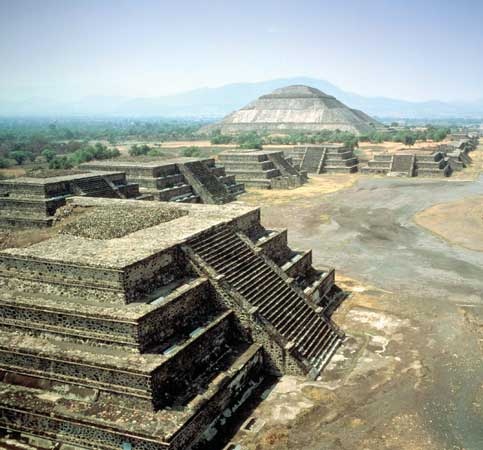 The major architectural construction in ancient America was evolving at this time and reached its apogee about AD 600. The city of Teotihuacán (outside present-day Mexico City), the “Home of the Gods,” exercised a tremendous influence from central Mexico into lower Central America; objects inspired by ideas originating at Teotihuacán are still being unearthed throughout the region. The famous masks (mask), so typical of the style, were made c. AD 250–750. Their monumental quality, formed by the great mass of stone from which the oval eyes, sensual mouth, and broad face are fashioned, provides a powerful sculptural concept. Far too massive to have been worn, it is more likely they were intended as burial offerings, or perhaps facial coverings for wooden effigies.
The major architectural construction in ancient America was evolving at this time and reached its apogee about AD 600. The city of Teotihuacán (outside present-day Mexico City), the “Home of the Gods,” exercised a tremendous influence from central Mexico into lower Central America; objects inspired by ideas originating at Teotihuacán are still being unearthed throughout the region. The famous masks (mask), so typical of the style, were made c. AD 250–750. Their monumental quality, formed by the great mass of stone from which the oval eyes, sensual mouth, and broad face are fashioned, provides a powerful sculptural concept. Far too massive to have been worn, it is more likely they were intended as burial offerings, or perhaps facial coverings for wooden effigies.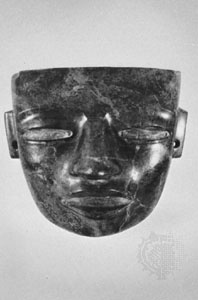 The Toltec, Mixtec, and Zapotec, widely separated one from the other, have also left their imprint. The former, spreading out from their home area around Tula, eventually travelled as far as the Yucatán Peninsula, leaving evidence of their culture wherever they went. The Zapotec and Mixtec peoples of Puebla and Oaxaca were famed for their unique arts, particularly Mixtec goldwork; these master craftsmen were sought out over great distances for the beautiful jewelry and finely fitted craftworks that are still so highly valued today.
The Toltec, Mixtec, and Zapotec, widely separated one from the other, have also left their imprint. The former, spreading out from their home area around Tula, eventually travelled as far as the Yucatán Peninsula, leaving evidence of their culture wherever they went. The Zapotec and Mixtec peoples of Puebla and Oaxaca were famed for their unique arts, particularly Mixtec goldwork; these master craftsmen were sought out over great distances for the beautiful jewelry and finely fitted craftworks that are still so highly valued today.Along the east coast, in the state of Veracruz, a group of Mayan people called the Huástec (Huastec) had settled by about 250 BC. In time they developed a new cultural expression, which, because they were isolated by Totonac settlers then building up a major centre at El Tajín, remained limited to their own group. Other pre-Totonac folk who were active in Veracruz produced innumerable “smiling face” figurines and related works that give an impression of an exuberant, happy people. Remarkable among these clayworks are the small clay whistles that abound in the area. They are valuable not only as artworks but also as examples of musical instruments popular during that period.
Unique to this region is the use of chapopote, a native asphalt commonly applied to clay figurines as a decoration; occasionally, chapopote entirely covers the figures, while in other examples it is used to decorate only the face, mouth, or eyes.
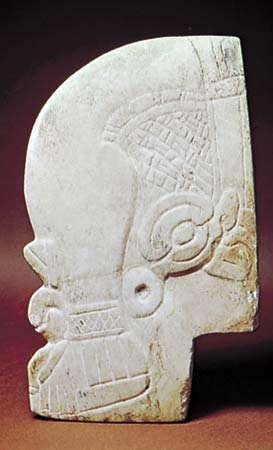 Some unusual stone carvings also were discovered in Veracruz. Although these objects have been found throughout Central America from central Mexico to El Salvador, their centre seems to have been in the coastal Veracruz area. One of the objects, the palma, or palmate stone (shaped like a hand with extended fingers), was first thought to have had some religious significance. Experts now consider the palma a ritual object or trophy representing an actual protective device—worn together with the yugo, or yoke, and the hacha, or axe—used in tlachtli, the ceremonial ball game. Tlachtli was not unlike modern football (soccer); the object was to propel a gutta-percha ball through the air without touching it with the hands; if it went through a small hole in the carved stone disk or hit the circular goal, the game was won. Tremendous exchanges of personal property resulted from such a victory—indeed, often life itself was forfeited in important contests.
Some unusual stone carvings also were discovered in Veracruz. Although these objects have been found throughout Central America from central Mexico to El Salvador, their centre seems to have been in the coastal Veracruz area. One of the objects, the palma, or palmate stone (shaped like a hand with extended fingers), was first thought to have had some religious significance. Experts now consider the palma a ritual object or trophy representing an actual protective device—worn together with the yugo, or yoke, and the hacha, or axe—used in tlachtli, the ceremonial ball game. Tlachtli was not unlike modern football (soccer); the object was to propel a gutta-percha ball through the air without touching it with the hands; if it went through a small hole in the carved stone disk or hit the circular goal, the game was won. Tremendous exchanges of personal property resulted from such a victory—indeed, often life itself was forfeited in important contests.As the Zapotec people of Oaxaca yielded in turn to the more warlike Mixtec, whose centre at Cholula was the site of the largest pyramid of the ancient world (it considerably exceeded the size of the pyramid of Giza in Egypt), so the latter in time became secondary to the Aztec. By 1200 these nomads, who came from the northwest, had established themselves in the central valley, which they called Méxica, whence the name Mexico. The world they built gave rise to a powerful—at times brutal—art form, in which stone was a favourite medium. The rounded, muscular figures that they produced were originally brilliantly painted, much like ancient Greek sculptures. The Aztec turned out an astonishing quantity of these figures, which, standing in rows, served as standard bearers along the avenues leading to various buildings.
 To the east and south, another completely different world appeared under the name of the Maya. Centring in Guatemala and Honduras, where the twin capitals of Quiriguá and Copán are still well-known sites, the Maya spread out to El Salvador, into what is today Belize, and into much of Mexico. The Yucatán Peninsula and the neighbouring state of Campeche are areas where a large number of Mayan sites have been found; of these, undoubtedly the most famous Mayan architectural monuments are at Uxmal, Labná, Kabah, and Sayil, and the most renowned examples of Mayan fresco painting are at Bonampak to the southwest. Chichén Itzá, the famous archaeological area near Mérida, combines both Maya and Toltec influences.
To the east and south, another completely different world appeared under the name of the Maya. Centring in Guatemala and Honduras, where the twin capitals of Quiriguá and Copán are still well-known sites, the Maya spread out to El Salvador, into what is today Belize, and into much of Mexico. The Yucatán Peninsula and the neighbouring state of Campeche are areas where a large number of Mayan sites have been found; of these, undoubtedly the most famous Mayan architectural monuments are at Uxmal, Labná, Kabah, and Sayil, and the most renowned examples of Mayan fresco painting are at Bonampak to the southwest. Chichén Itzá, the famous archaeological area near Mérida, combines both Maya and Toltec influences. Just off the coast of Campeche is the island cemetery of Jaina, from which have come magnificently modelled figurines that are certainly among the finest clay works of antiquity. These sacrificial burial figures, replicas of Mayan personages in ceremonial finery, provide a remarkable insight into the customs, lifestyles, and costumes of the Classic Mayan people.
Just off the coast of Campeche is the island cemetery of Jaina, from which have come magnificently modelled figurines that are certainly among the finest clay works of antiquity. These sacrificial burial figures, replicas of Mayan personages in ceremonial finery, provide a remarkable insight into the customs, lifestyles, and costumes of the Classic Mayan people.Compared with Aztec sculpture, Mayan art forms are relatively delicate. Yet, although light tracery is characteristic of their sculpture and painting, strong forms and lines are also in evidence. Perhaps the Maya were the most art-conscious people of the ancient Americas; certainly everything they created seems to have been in terms of aesthetics. They were competent in the use of many raw materials—shell, bone, stone of various kinds, wood, fibres, even feathers became part of their art. Surprisingly, with all of their skills, they seem never to have undertaken much metalwork: gold, silver, and copper objects are exceedingly rare at Mayan sites.
Present as early as 1500 BC, the Maya began to rise in power about AD 250. The Mayan civilization had reached its apogee about 750 and had disappeared by 900. Remnant groups kept the cultural thread as a continuum up to about 1200, but by then, except for their languages (Maya languages), they could no longer be regarded as cognate with the earlier Maya.
Farther south, in Nicaragua, Costa Rica, and Panama, the relationships of the various people are less clear, owing largely to the relative paucity of archaeological work that has been undertaken. Moreover, because Panama was something of a crossroads, both east-west and north-south, the variety of influences found there makes conclusive evaluations of the native art almost impossible. But even though far less is known about these peoples, there is no question about the excellent quality of their various kinds of artwork.
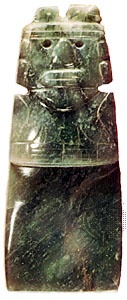 The two greatest artistic achievements of the region seem to have been in jade carving and goldsmithing. From the isthmus area come some of the finest gold castings known. Although some delicate, finely wrought goldwork is known, most pieces consist of heavy casting, with lost-wax tracery (interlaced patterns of metal cast in a wax mold) in which animal and bird forms predominate. The polished jadework of Costa Rica is famous throughout the Central American area. The beautiful “ax gods,” carved from green jade, must have been as sought after in ancient times as they are today.
The two greatest artistic achievements of the region seem to have been in jade carving and goldsmithing. From the isthmus area come some of the finest gold castings known. Although some delicate, finely wrought goldwork is known, most pieces consist of heavy casting, with lost-wax tracery (interlaced patterns of metal cast in a wax mold) in which animal and bird forms predominate. The polished jadework of Costa Rica is famous throughout the Central American area. The beautiful “ax gods,” carved from green jade, must have been as sought after in ancient times as they are today.Pottery was not an unknown art, and the brilliantly painted vessels found here are emphatic proof of this fact. Surprisingly, the art has yet to receive the recognition due it on aesthetic grounds. Some of the designs are remarkably intricate, bold in form, and frequently as sophisticated as anything found in the Western Hemisphere. And here and there are intriguing touches of humour—a quality largely absent from Aztec and Mayan arts.
Little has survived of the architectural expressions from this area. Some large stone sculptures from Penonomé, in Coclé province, Panama, suggest that the use of stone in large structures was not unknown; but apparently all of these structures were destroyed, in the years after the Spanish conquest, by people using the stones for building.
Following the conquest, the eradication of native culture in Central America was more rigorous than in many areas, and the net result is that, south of Guatemala, the break with traditions of the past is virtually complete. There are some remnants in Costa Rica, but they are few, and evidence of their pre-Columbian culture (Mesoamerican civilization) is only marginal. Today, such arts and crafts as are pursued may reflect a continuum of design, but they are syncretic, incorporating elements of European art with indigenous traditions (see also Latin American art). The only regions in which considerable prehistoric aesthetic influence survives are Mexico and Guatemala (Mesoamerican Indian), where native artisans have been able to keep their arts somewhat alive by recourse to ancient designs and functions.
Regional style: West Indies
The Caribbean region has undoubtedly lost more of its aboriginal character than any other region of the Americas. The almost total extirpation of the islands' population shortly after the conquest and the subsequent repopulation of the area by black slaves made any carryover of Indian cultural expressions impossible. For this reason the residents of those islands rarely feel any sense of relationship to the ancestral inhabitants. Certainly it is true that the average non-Indian has no understanding of the wealth of arts that were to be found there in the past.
The delicate wood carvings, textiles, featherwork, and related perishable objects that are known from references in Spanish accounts to have existed have largely disappeared. Only a few wood carvings and a small number of shell and bone carvings are known. The great strength of surviving prehistoric art from the area is in stone; and in this medium there are remarkably sophisticated, powerful works. Small tripointed carvings that were often human or zoomorphic in form represented the spirits (zemi) of the land. The Taino culture is famous for these zemi carvings, which are found in many of the islands, notably Puerto Rico and Hispaniola. Carved stone pestles with human and animal designs are also common, along with strange “stone collars”—oval carvings that may be related to the yugos of Mexico and Guatemala. The most prevalent form, however, is the human head, often a death's-head, which suggests a culture preoccupied with mortality. The peoples of this area were also fascinated by odd shapes in stone. Unusual “comma stones,” the meaning of which—if they had any—scholars have been unable to discover, have been found scattered throughout the Antilles. Their number and the care and skill with which they were carved suggest that they had an important role in the culture.
Although the Taino are thought to have surpassed the other peoples of the West Indies in aesthetic development, examples of later artistic forms and techniques characteristic of the Arawak, Carib, and related tribes still surviving in neighbouring South America may provide a link between ancient and modern. Since the Taino were a division of the Arawak, so may modern Arawak weaving indicate something of what must have existed among the prehistoric Taino.
The trans-Caribbean sea route from the islands to the mainland obviously carried cultural influences, as well as materials, back and forth; but far too little is known about these influences to be able to determine which area (the islands or the mainland) was most affected. As a consequence, little more is known about the West Indies civilization other than that it produced extremely successful sculpture. The civilization itself was conquered so rapidly and completely that one can only admire but not wholly comprehend it.
Regional style: South America (South American Indian)
Colombia, Ecuador, and Brazil
The greatest single problem in assessing the Indian art of this region is the unfortunate historical tendency to lump everything together under the heading “Inca,” as though no other culture had ever attained significance. In point of fact, when one undertakes to examine the continent critically, it is evident that the Incas were among the least aesthetically remarkable of the various peoples of South America, almost all of whom attained artistic levels that were only occasionally equaled by the latecomers. It is probably only in the architectural use of stone and in the textile arts that the Incas held their own in artistic comparison.
Weaving was one of the three arts that were South American strengths, the two others being metalwork and pottery. No other peoples in the Western Hemisphere—and less than a handful elsewhere in the world—came close to equaling the aesthetic and technical accomplishment of the Peruvian weaver. One can imagine the astonishment of the early Spanish explorers when they saw this radiant clothing for the first time, even though they very soon passed it over for the gold they coveted.
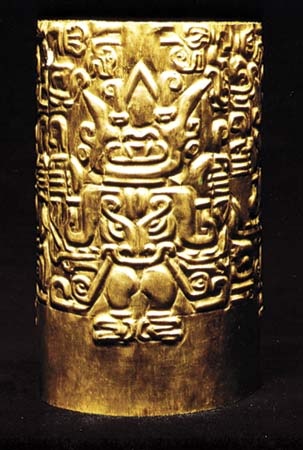 Metalwork was at its zenith in Peru, Colombia, and Ecuador, each of which developed major cultures whose arts were equal to the demands of the raw material. Tairona gold, in Colombia, rates very high in design and craftsmanship, as does the work of the Quimbaya, whose skill in creating polished metal flasks is remarkable. Notable also is Sinú casting, which could execute works weighing several pounds. In Ecuador the goldwork found at La Tolita is legendary and shows a skill in casting and overlay that did not seem to exist elsewhere in the region. In Peru most surviving goldwork was created by the Chimú and Nazca peoples. Yet, that this was a well-advanced art as early as the Chavín era is demonstrated by major discoveries at Chongoyape; indeed, these pieces seem to be the earliest gold products in America, having been created about 900–500 BC.
Metalwork was at its zenith in Peru, Colombia, and Ecuador, each of which developed major cultures whose arts were equal to the demands of the raw material. Tairona gold, in Colombia, rates very high in design and craftsmanship, as does the work of the Quimbaya, whose skill in creating polished metal flasks is remarkable. Notable also is Sinú casting, which could execute works weighing several pounds. In Ecuador the goldwork found at La Tolita is legendary and shows a skill in casting and overlay that did not seem to exist elsewhere in the region. In Peru most surviving goldwork was created by the Chimú and Nazca peoples. Yet, that this was a well-advanced art as early as the Chavín era is demonstrated by major discoveries at Chongoyape; indeed, these pieces seem to be the earliest gold products in America, having been created about 900–500 BC.Perhaps the art that was most widespread and had the greatest variety of form is pottery. In the exciting range of imaginative forms, exuberant vessels are found side by side with sombre, formal works. The use of brilliant colour is common, and the degree of careful modeling makes of many of these pottery containers veritable sculptural masterpieces.
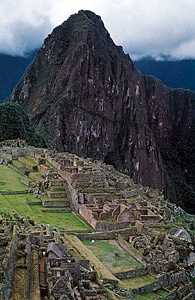 A popular material, stone was used throughout most of South America for massive forms; the small delicately traced stone carvings found in Central America are rarely encountered south of that region. Architecturally, the Incas surpassed all others in their use of intricately cut, giant-size stone blocks, at the sites of Machu Picchu, Sacsahuamán, and Ollantaytambo. Only in San Agustín, in Colombia, was there a similar monumental use of stone. In Manabí, in Ecuador, blocks of stone were skillfully carved into thrones and huge seats.
A popular material, stone was used throughout most of South America for massive forms; the small delicately traced stone carvings found in Central America are rarely encountered south of that region. Architecturally, the Incas surpassed all others in their use of intricately cut, giant-size stone blocks, at the sites of Machu Picchu, Sacsahuamán, and Ollantaytambo. Only in San Agustín, in Colombia, was there a similar monumental use of stone. In Manabí, in Ecuador, blocks of stone were skillfully carved into thrones and huge seats. Colombia
Colombia is among the first South American regions to have enjoyed settlement. A pre-pottery Indian culture is known to have come into the region about 10,000 BC, and Puerto Hormiga excavations reveal that a pottery-making culture existed as early as 3000 BC. The more definite cultural expressions, however, are not found in quantity until San Agustín, which came into existence with the advent of the Common, or Christian, Era. Little pottery has been recovered from the region as yet, but stone carvings are very well known. Two later cultures north of this site, which have yielded a more generous quantity of art objects, are Calima, known for its goldwork, and Quimbaya, whose gold and pottery are both important cultural indicators.
Since the southern and eastern regions of the country are almost unknown archaeologically, conclusive evidence is absent, but at the moment it does not appear that their prehistory was artistically rich. Early pre-pottery sites have been found, notably at El Jobo, in Falcón, that date to about 14,920 BC. Carved stone was used for such objects as small pendants or fetishes; shell and bone are also known to have been used.
It is certain that this was a contact point with many of the Antillean peoples and that travel back and forth between the two regions was a regular custom. Columbus reported such trade—which seems to have been a longtime practice—at the time of his arrival.
Ecuador
It is to Ecuador that one must turn for an examination of early art forms. Straddling the Equator, as the name implies, this region—today the smallest republic in South America—is one of the most intriguing on the continent. For decades the region had been ignored by scholars in favour of the more glamorous Peruvian area, but in the late 20th century its tremendous antiquity began to be recognized. It now seems that ancient humans may have established their first South American foothold in Ecuador and that the region is also the site of the earliest datable pottery. From perhaps as early as 15,000 BC until about 3200 BC, when pottery was known to exist at Valdivia, there was a long, steady period of development in the region. And the development was not spotty, for the population increase was also constant.
Although the great cities and some of the major cultural activities found farther south were not found in Ecuador, there was nevertheless considerable cultural accomplishment. Weaving was done in quantity, as evidenced by Spanish accounts; and, more spectacularly, goldsmithing was a major expression of the artist's skill. Large pieces, such as crowns and breastplates, and tiny miniatures reflecting the sureness of a master's hand have been found. None of these pieces is unique; they are known in sufficient quantity to prove the existence of a longtime craft. Literally hundreds of thousands of tiny gold beads, each cast individually, have been found in the sands of La Tolita; and others, slightly larger, with granulated surfaces indicating the mastery of a complex casting process, have also been recovered. The technique of inlaying had also been mastered, and the use of emeralds and other gemstones as settings was commonplace. Platinum was worked, as in Colombia; not only was it cast but it also was frequently used in combination with other metals. Copper too was worked, both in its pure form and combined with tin to make bronze; occasionally, it was gilded to create a pseudo-gold finish. Heavy cast copper axes were stock-in-trade, and many smaller objects were turned out in quantity.
The pottery that emerged from the hands of the clay workers was of high quality, beautifully designed and well finished. The modeling was powerful, and there were touches of humour. Scholars are not sure to what extent colour was used, for time and soil have removed much of it. Modeled clay effigies discovered in 1966 at Bahía de Manta are not only remarkable for their size and quantity but even more for the astonishing amount of original colour that had been preserved.
Brazil
Little is actually known of the archaeology of the vast region of Brazil. Only around the Amazon area has very much work been done, and there primarily on the Ilha de Marajó (Marajó Island). Size has hampered much of the effort to unravel prehistory, but weather conditions and jungle overgrowth have also combined to resist penetration. What is known, however, is tantalizing to the scholar, for at Lagoa Santa, in Minas Gerais, the bones of a human being have been linked with a mammoth slaughtered for food as early as 10,000 BC; and pottery vessels have been discovered attesting to a remarkably advanced civilization in the Amazon lowlands perhaps as early as AD 1000. But what lies between these two extremes in time is yet to be discovered.
The most aesthetically exciting object excavated in Brazil is a unique pottery form, found on the Ilha de Marajó and called Marajoara, which incorporates modeling and painting with a low relief carving of the surface. Several successful expeditions have recovered modest amounts of material, but the island, which is regularly flooded by the mouth of the Amazon, has resisted complete excavation. An individual style found on the tiny isle of Maracá, and another from Santarém, suggest the existence in this region of a hodgepodge of aesthetic expressions, some related, some alien. Surprisingly, the strong geometric Marajoara style seems not to have influenced any of the cultures around it.
Peru and highland Bolivia
The great civilizations of Peru and highland Bolivia—with their monolithic stone structures, major political organizations, and elaborate material wealth—have long attracted the attention of the outside world. This was the only area where structures of any real magnitude were built in South America; the ruins of Tiwanaku, Cuzco, Chan Chan, and similar well-developed urban centres attest to the achievement of highly skilled peoples. Pottery has been found in all styles and types, from relatively crude wares to the most highly painted and polished masterpieces. Whistling vessels are common, and the various forms of musical instruments perhaps exceed those found in other civilizations on the continent. Representations of daily life on the pottery reflect complete, well-rounded civilizations.
Humans were definitely active in Peru as early as 10,000 BC, and pottery making there dates to no later than 1200 BC. Slowly these dates will be pushed back as scholars unravel more and more of prehistory, for, in view of the advanced stage of some early works, it is certain that they will be found to have been preceded by others.
The great Peruvian ruins around Chavín de Huántar have given the name Chavín to one of the most remarkable civilizations in South America—and one of the earliest, though it was apparently not coeval with the Valdivia of Ecuador (c. 3200 BC). There remnants, famous throughout the archaeological world, have been found of one of America's earliest cultures. Carved stone objects, fantastic pottery that demonstrates the most advanced skills, evidences of stone construction, and remarkably sophisticated goldwork all bear witness to a truly magnificent era in ancient history.
Another discovery has brought to light evidence of an early civilization at Ayabaca, in Piura in northwestern Peru, that was probably coeval with the Chavín. Named Vicús after the valley in which it was uncovered and dating between 250 BC and AD 500, this civilization produced pottery that resembles the ware of nearby Ecuador and goldwork not unlike other early forms. The discovery of this civilization, unknown until the late 1960s, suggests the existence of others.
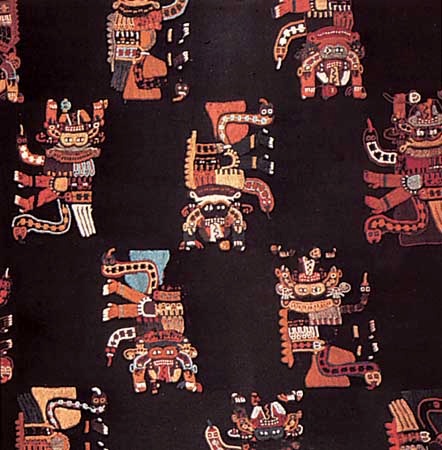 South of the Chavín region, another high culture developed around the Paracas Peninsula. This civilization produced a famous thin-walled pottery and some of the most extraordinary textiles in existence. Great woven mantles, ponchos, and small tapestries were created between 1000 and 250 BC.
South of the Chavín region, another high culture developed around the Paracas Peninsula. This civilization produced a famous thin-walled pottery and some of the most extraordinary textiles in existence. Great woven mantles, ponchos, and small tapestries were created between 1000 and 250 BC.Just as elements from the Chavín civilization filtered south to influence the Paracas people, so they influenced a development in the north, around the Virú, Chicama, and Moche valleys from 250 BC to AD 750. Commonly called Moche, these people developed a mature art form that includes some of the finest plastic sculpture in the history of pottery. The range of designs makes these objects remarkable not only as art but also as a record of the civilization from which they come. The extensive number of objects produced suggests that the civilization was an extremely populous one, in which power and wealth were major goals.
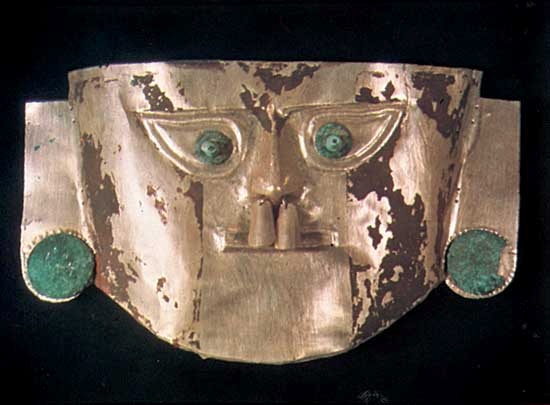 Gradually this civilization gave way to that of invaders, the Chimú, whose capital of Chan Chan was from AD 1000 to 1500 one of the great urban centres of ancient Peru. This huge city, now largely destroyed, once housed 100,000 persons and produced a spectacular array of artistic works: gold jewelry, feather mantles, great textiles, and considerable work in wood and clay. The arid climate has preserved more art from the Chimú region than from many other sections, and Spanish accounts aid scholars in understanding those artifacts. Pottery was as skilled as any found elsewhere, although by the period under examination something of a paralysis had set in; certainly, many of the designs have a static quality, doubtless owing to the extensive use of molds. Customer demand must have been so great that the craftsman had to resort to mass production to keep up with his clients.
Gradually this civilization gave way to that of invaders, the Chimú, whose capital of Chan Chan was from AD 1000 to 1500 one of the great urban centres of ancient Peru. This huge city, now largely destroyed, once housed 100,000 persons and produced a spectacular array of artistic works: gold jewelry, feather mantles, great textiles, and considerable work in wood and clay. The arid climate has preserved more art from the Chimú region than from many other sections, and Spanish accounts aid scholars in understanding those artifacts. Pottery was as skilled as any found elsewhere, although by the period under examination something of a paralysis had set in; certainly, many of the designs have a static quality, doubtless owing to the extensive use of molds. Customer demand must have been so great that the craftsman had to resort to mass production to keep up with his clients.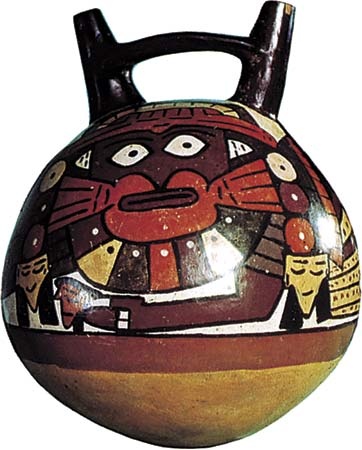 In the south a great pottery talent was at work from c. 250 BC to AD 750 around the Nazca Valley. There, perhaps the most technically advanced potters in South America were producing perfectly formed clay vessels, highly fired, brilliantly painted, and often intricately fashioned. Mostly mold-made, they were turned out in great quantities, with the same stiff formality seen in Chimú pottery. The Nazca weavers, however, succeeded in defeating the mass market, for their work was devoted to highest quality, and their skill was such that even though miles of similarly patterned cloth were turned out regularly, the repetition did not destroy its beauty. In fact, the overall patterns so frequently seen provide a harmony that results in a beautiful fabric. There was literally no weaving process unknown to the ancient Peruvians. Nazca goldwork seems not to have been up to the standards achieved by other Peruvian metalwork; by and large it is a listless product, having only the material to recommend it. Thin, hammered sheet gold was commonly used for Nazca ornamentation.
In the south a great pottery talent was at work from c. 250 BC to AD 750 around the Nazca Valley. There, perhaps the most technically advanced potters in South America were producing perfectly formed clay vessels, highly fired, brilliantly painted, and often intricately fashioned. Mostly mold-made, they were turned out in great quantities, with the same stiff formality seen in Chimú pottery. The Nazca weavers, however, succeeded in defeating the mass market, for their work was devoted to highest quality, and their skill was such that even though miles of similarly patterned cloth were turned out regularly, the repetition did not destroy its beauty. In fact, the overall patterns so frequently seen provide a harmony that results in a beautiful fabric. There was literally no weaving process unknown to the ancient Peruvians. Nazca goldwork seems not to have been up to the standards achieved by other Peruvian metalwork; by and large it is a listless product, having only the material to recommend it. Thin, hammered sheet gold was commonly used for Nazca ornamentation.Closely related to, and extending from, the Nazca work is the art of the Ica civilization (AD 1000–1500). These people produced fine textiles, the designs of which were often reproduced on the pottery of the area. The dry climate has also preserved a wealth of wood carving, much of it in such fine condition that the quality of the art can be clearly seen.
In the central Peruvian area, a group of people emerged, built a modest civilization, and developed it into a world that was in existence when the Spanish arrived. The Chancay people are not known for great artworks; their pottery, produced from AD 1000 to 1500, is a simple black-on-white ware, usually painted in soft colours, simply defined, and frequently crude in appearance. Their one outstanding quality is humour; many Chancay vessels show a lively sense of the absurd, almost providing a Peruvian comic strip. Chancay weaving is excellent, and many thousands of surviving examples attest to this technical preeminence.
Farther afield, in Bolivia, another major civilization had been developing: the Tiwanaku world. Its origin and the whole story of its development are not yet fully understood, but it is known that it came to exert a tremendous influence over a wide area of South America from AD 250 to 750. One of its most characteristic qualities was the use of stone—in walled cities, huge doorways with intricately carved paneling, and great paved roads. Tiwanaku art is a rather angular expression, with repetitive, rather unoriginal motifs. The pottery from this site is equally uninspiring; although strong in colour, it does not show the variety and technical perfection seen in the wares of the nearby Inca and Nazca. Again, the great art is weaving. It seems that in many cultures the attention devoted to the textile arts far overshadowed that devoted to all of the other arts. And so it is with the Tiwanaku, who produced ponchos, caps, pouches, and other costume pieces that are instantly recognizable wherever seen and challenge the contemporary weaver with their variety, fantastically tight weave, and remarkable richness of colour.
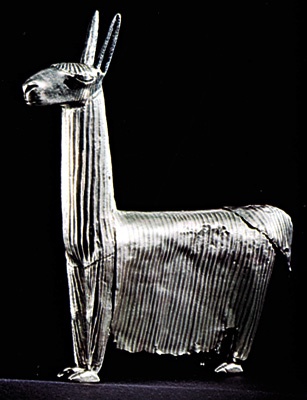 The Inca civilization had begun about AD 1200, but the empire itself was not established until 1438, with the accession of Pachacuti Inca Yupanqui, the greatest of the Inca rulers. With the arrival of the Spanish (Spain) in 1532, the empire was at its height but was suffering from a schism that proved fatal in the face of the European attack. So savage was the Spanish invasion that the empire, numbering some 6 million individuals at its height, was left without a head, and, within a period of 30 years, its population had dwindled to 1.5 million. Part of this legacy is that less art survives from the Inca culture than from many of the far older Peruvian cultures; there are many more Tiwanaku ponchos known than those from the Inca period, for example. Enough has survived, however, to enable scholars to characterize Inca art forms. The aryballus (globular bottle for liquids) is known the world over, and stonework was common and of excellent quality. Silver (silverwork) and gold (goldwork) were no mystery to the Inca; religious tribute was claimed in the form of worked metal (metalwork), treated as a gift to the sun god. Indeed, it was this very practice that proved the Inca's undoing, for the Spanish treasure seekers abandoned all other pursuits in their greed for precious metals. In due course, the Inca civilization declined to a point where it was little more than a shell.
The Inca civilization had begun about AD 1200, but the empire itself was not established until 1438, with the accession of Pachacuti Inca Yupanqui, the greatest of the Inca rulers. With the arrival of the Spanish (Spain) in 1532, the empire was at its height but was suffering from a schism that proved fatal in the face of the European attack. So savage was the Spanish invasion that the empire, numbering some 6 million individuals at its height, was left without a head, and, within a period of 30 years, its population had dwindled to 1.5 million. Part of this legacy is that less art survives from the Inca culture than from many of the far older Peruvian cultures; there are many more Tiwanaku ponchos known than those from the Inca period, for example. Enough has survived, however, to enable scholars to characterize Inca art forms. The aryballus (globular bottle for liquids) is known the world over, and stonework was common and of excellent quality. Silver (silverwork) and gold (goldwork) were no mystery to the Inca; religious tribute was claimed in the form of worked metal (metalwork), treated as a gift to the sun god. Indeed, it was this very practice that proved the Inca's undoing, for the Spanish treasure seekers abandoned all other pursuits in their greed for precious metals. In due course, the Inca civilization declined to a point where it was little more than a shell. Chile and Argentina
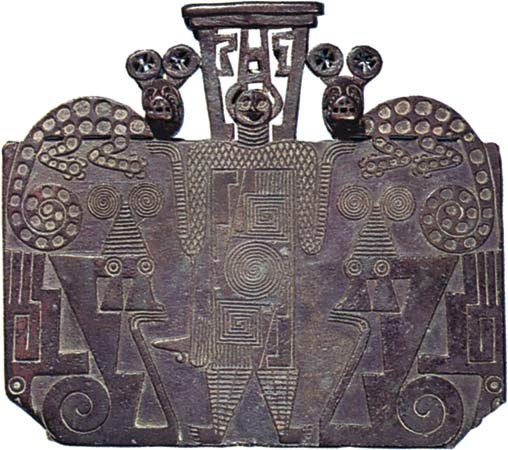 The Monte Verde site in Chile is the oldest firmly dated human habitation site in the Americas, at 10,500 BC. About 500 BC, pottery-making people became active in the south. However late human habitation was, civilizations developed quickly. Wandering back and forth over the Andes, humans settled both Chile, where they were known as Diaguita, and northern Argentina, where they were known as Chalchaquí. Very soon the peoples of this region developed their own arts, some of which are unique. They produced fine pottery and strong, colourful textiles. Gold was never a major product, although copper became an important metal, partly because of its prevalence. The people cast huge copper disks and plaques and made special burial urns for their children, even reserving cemetery areas in a touching demonstration of affection. The period of Diaguita settlement covered about 1,500 years, or from approximately AD 1 to 1500.
The Monte Verde site in Chile is the oldest firmly dated human habitation site in the Americas, at 10,500 BC. About 500 BC, pottery-making people became active in the south. However late human habitation was, civilizations developed quickly. Wandering back and forth over the Andes, humans settled both Chile, where they were known as Diaguita, and northern Argentina, where they were known as Chalchaquí. Very soon the peoples of this region developed their own arts, some of which are unique. They produced fine pottery and strong, colourful textiles. Gold was never a major product, although copper became an important metal, partly because of its prevalence. The people cast huge copper disks and plaques and made special burial urns for their children, even reserving cemetery areas in a touching demonstration of affection. The period of Diaguita settlement covered about 1,500 years, or from approximately AD 1 to 1500.With the extension of the Inca empire into the Chilean and Argentine regions, the ubiquitous aryballus form found its way there, as did other, similar Inca expressions. Indeed, the pottery forms give a clue as to the presence or absence of the Inca overlords.
With the arrival of the Europeans all of this changed. Of all of the South American Indian civilizations, only in Ecuador, Peru, Bolivia, and Chile is there anything like a continuum of native arts. And even in these the European influence has been so pervasive as to eradicate all but the most dominant aesthetic characteristics.
Arts of the American Indian peoples in the contemporary world
In the contemporary art world, Native American art occupies a peripheral role. Until the last few decades, the only strong effort to exhibit this art in galleries or museums was made by those few institutions specializing in ethnological, exotic, or art history subjects, together with the rare specialized museum devoted only to Indian materials or to those of the American West.
The most active interest in American Indian art seems to have been less in products of still-living cultures than in prehistoric arts and less in the arts of prehistoric North American peoples than in “pre-Columbian art,” which is generally understood to mean the works of the so-called high civilizations—notably the Maya, Aztec, Inca, and Moche. This is to be regretted, for it not only results in an overemphasis that destroys intellectual balance but it also has relegated to the background some of the more exciting aesthetic accomplishments of the Native American. The diorite bowl representing a crested wood duck that has been called by some “the Portland vase of America” is not an isolated instance, for there are other fine sculptures equally deserving of attention.
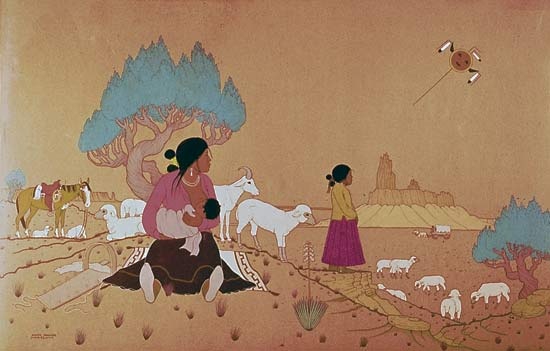 More active efforts to preserve American Indian art have been made in the United States than elsewhere. The first was in the 1920s, when a group of Euro-American artists located in and around Santa Fe, N.M., found excitement in the work of the Indians of the Southwest. Together with the so-called Taos colony of artists, these influential people succeeded in bringing the values of Native American art to the attention of the outside world through publications, exhibitions, and their artworks, in which Indian design often figured predominantly. In time, this group saw to the establishment of a School of Indian Art in Santa Fe. Out of this school came many of the most familiar names in Indian art. Oqwa Pi, Jack Hokeah, Awa Tsireh, Pablita Velarde, Andy Tsinajinnie, Allan Houser, Ben Quintana, Gerónima Cruz Montoya, Eva Mirabal, and Waldo Mootzka are but a very few of the students involved during this exciting period. Following an initial success, the school enjoyed a period of prosperity but then fell victim to the Great Depression.
More active efforts to preserve American Indian art have been made in the United States than elsewhere. The first was in the 1920s, when a group of Euro-American artists located in and around Santa Fe, N.M., found excitement in the work of the Indians of the Southwest. Together with the so-called Taos colony of artists, these influential people succeeded in bringing the values of Native American art to the attention of the outside world through publications, exhibitions, and their artworks, in which Indian design often figured predominantly. In time, this group saw to the establishment of a School of Indian Art in Santa Fe. Out of this school came many of the most familiar names in Indian art. Oqwa Pi, Jack Hokeah, Awa Tsireh, Pablita Velarde, Andy Tsinajinnie, Allan Houser, Ben Quintana, Gerónima Cruz Montoya, Eva Mirabal, and Waldo Mootzka are but a very few of the students involved during this exciting period. Following an initial success, the school enjoyed a period of prosperity but then fell victim to the Great Depression.Another surge of interest came with the enactment of the Indian Reorganization Act of 1934, by means of which the Indian Arts and Crafts Board came into existence. Sparked by John Collier, then commissioner of Indian affairs, this body is one of the few governmental organizations set up specifically to promote, encourage, and revive native arts and crafts. While intended largely as an economic device to increase Native American income, the board fortunately included members who were knowledgeable about, and sensitive to, the aesthetic and cultural strengths of Native American cultures. A program of exploration revealed surprising resilience in native crafts, and a core of still-active craftspeople who remembered older techniques was engaged to perpetuate their arts. Out of this program came a renaissance that still continues, even after the board has become less influential, as the native artist more and more finds himself in his art. What promises to become the major factor influencing Indian art is the Institute of American Indian Arts in Santa Fe, an outgrowth of the early interest of the Indian Arts and Crafts Board in assisting young Native American artists in securing needed training.
Stimulated by these developments, the interest of art museums and collectors in native art brought home to the general public the existence of a remarkable, if overlooked, art form.
Today a growing interest in Indian cultural expression is found among many North American Indians. Many Indians want to learn what they can of their past and salvage what can be preserved.
Perhaps the greatest positive force to appear in some time are the Indian tribal councils and economic development boards, many of which support the arts in their own areas, not only to augment income but also out of an awareness of the cultural value of those arts. Many tribes, particularly the Navajo, Hopi, Cherokee, and Crow, have set up funds to develop crafts areas, sales centres, and museums to promote the appreciation of their traditional arts and thereby strengthen the fabric of the tribe. Some have set up crafts schools so that the younger people will have access to the necessary training.
Painting has taken several new and positive directions. Many Native American artists are creating remarkable works in acrylic, tempera, oil, and related media, gaining recognition in the fine arts and establishing successful careers in the world at large. Reflecting their own diverse interests and identities, some prefer to paint in a completely free manner, meaning that their work will not necessarily reflect their ancestry. Others seek means whereby they can paint in “Indian style” or combine native themes and techniques with those of other cultures.
In other parts of the Western Hemisphere, organizations similar to those in the United States have been established to promote native crafts movements. In general, such movements find their greatest support in areas where nationalism is on the rise and pride in one's background is preeminent. The Latin American nation that has taken the most effective steps in this direction has certainly been Mexico; its National Museum of Archeology (National Museum of Anthropology), built in 1964, is perhaps the finest such structure in the world and stands as a monument to the heritage of that country. Guatemala, Colombia, Peru, and Ecuador also have devoted major architectural attention to their native cultures.
Additional Reading
General works
Overviews of Native American art can be found in Miguel Covarrubias, The Eagle, the Jaguar, and the Serpent (1954, reissued 1967), a splendid volume on the arts of the Americas, with many line drawings and colour plates by the author, a major Mexican artist, continued by Indian Art of Mexico and Central America (1957), one of the best single treatments on the formative centuries of ancient Mexican civilization; Frederick J. Dockstader, Indian Art in America: The Arts and Crafts of the North American Indian, 3rd ed. (1966), a survey of the native arts of the United States and Canada, Indian Art in Middle America (also published as South American Indian Art, 1964), extending the area of study to the southern boundary of Panama, with particular emphasis on the lesser-known tribes of the region, and Indian Art in South America (1967), the final volume in this series, completing a survey of the entire range of aboriginal art of the New World; and Jamake Highwater, Arts of the Indian Americas: Leaves from the Sacred Tree (1983), an introduction to various art forms of the Americas.Studies of pre-Columbian art include Ferdinand Anton and Frederick J. Dockstader, Pre-Columbian Art and Later Tribal Arts (1968), a popular treatment that covers the Western Hemisphere, extremely valuable for the many illustrations, most of which are in colour; Pál Kelemen, Medieval American Art, 3rd rev. ed., 2 vol. (1969), a rich sourcebook of illustrations that includes the entire hemisphere; Jan Mitchell, The Art of Precolumbian Gold, ed. by Julie Jones (1985); and Manuel Lucena Salmoral, America 1492: Portrait of a Continent 500 Years Ago (1990; originally published in Spanish, 1990), providing an impressive pictorial glimpse of Native American life and art about 1492.Other works on Native American antiquities are Franz Boas, Primitive Art, new ed. (1955), a classic with considerable discussion of the place of native arts in European society—especially helpful for the section on Northwest Coast art; Hans D. Disselhoff and Sigvald Linne, The Art of Ancient America (1960; originally published in German, 1955), a well-illustrated volume that concentrates primarily upon the prehistoric cultures of Central and South America and largely ignores North American Indian art; Geoffrey H.S. Bushnell, Ancient Arts of the Americas (1965), a general treatment of the Western Hemisphere, with greater attention given to Latin America; and Pál Kelemen, Art of the Americas, Ancient and Hispanic (1969), a well-illustrated study of the earlier periods of the Americas, particularly valuable for its inclusion of the colonial influences on Indian aesthetics. Later studies include Richard F. Townsend (ed.), The Ancient Americas: Art from Sacred Landscapes (1992), an exhibition catalog.
North America: United States and Canada
Overviews are found in Frederic H. Douglas and Rene d'Harnoncourt, Indian Art of the United States (1941, reprinted 1969); Wolfgang Haberland, The Art of North America, rev. ed. (1968); Peter T. Furst and Jill L. Furst, North American Indian Art (1982), a wide-ranging study with illustrations; Edwin L. Wade and Carol Haralson (eds.), The Arts of the North American Indian: Native Traditions in Evolution (1986); Ralph T. Coe, Lost and Found Traditions: Native American Art, 1965–1985 (1986), a treatment of the contemporary development of the native tradition; Jerry Jacka and Lois Essary Jacka, Beyond Tradition: Contemporary Indian Art and Its Evolution (1988); Christine Mather, Native America: Arts, Traditions, and Celebrations (1990); Christian F. Feest, Native Arts of North America, updated ed. (1992); David W. Penney and George C. Longfish, Native American Art (1994); and Jeremy Schmidt and Laine Thom, In the Spirit of Mother Earth: Nature in Native American Art (1994).Native American art of the Northwest Coast in particular is examined in Robert T. Davis, Native Arts of the Pacific Northwest (1949, reissued 1954); Robert B. Inverarity, Art of the Northwest Coast Indians (1950, reissued 1971); Dorothy Jean Ray, Eskimo Art: Tradition and Innovation in North Alaska (1977), and Aleut and Eskimo Art: Tradition and Innovation in South Alaska (1981), useful studies covering history, analysis, and interpretation; Audrey Hawthorn, Kwakiutl Art (1979, reissued 1988), an informative history and assessment; Claude Lévi-Strauss, The Way of the Masks (1982; originally published in French, 1975); Bill Holm, The Box of Daylight: Northwest Coast Indian Art (1983), an exhibition catalog featuring scholarly essays that cover various art forms from everyday to ceremonial; and Maximilien Bruggmann and Peter R. Gerber, Indians of the Northwest Coast (1989; originally published in German, 1987), a regional overview. Totem poles of the Pacific Northwest are the subject of Marius Barbeau, Totem Poles, 2 vol. (1950–51, reissued 1990); Hilary Stewart, Totem Poles (1990); and Aldona Jonaitis, From the Land of the Totem Poles (1988).Other traditions are treated in Clara Lee Tanner, Southwest Indian Craft Arts (1968); Patrick Houlihan et al., Harmony by Hand: Art of the Southwest Indians, Basketry, Weaving, Pottery (1987); Helga Teiwes, Kachina Dolls: The Art of Hopi Carvers (1991); and Margaret Archuleta and Rennard Strickland (eds.), Shared Visions: Native American Painters and Sculptors in the Twentieth Century, 2nd ed. (1993); and in these exhibition catalogs: David S. Brose, James A. Brown, and David W. Penney, Ancient Art of the American Woodland Indians (1985); Barbara A. Hail and Kate C. Duncan, Out of the North (1989), with extensive textual coverage of the arts of subarctic peoples; Diana Fane, Ira Jacknis, and Lise M. Breen, Objects of Myth and Memory (1991), a well-researched work covering the art of western North American native peoples in great detail; David W. Penney et al., Art of the American Indian Frontier (1992); Evan M. Maurer et al., Visions of the People: A Pictorial History of Plains Indian Life (1992), with detailed essays; and Richard F. Townsend (ed.), Hero, Hawk, and Open Hand: American Indian Art of the Ancient Midwest and South (2004).Treatments of various individual media are found in many specialized works. Discussions of architecture include Stephen C. Jett and Virginia E. Spencer, Navajo Architecture: Forms, History, Distributions (1981), a comprehensive survey; and Peter Nabokov and Robert Easton, Native American Architecture (1989).Basketry is the focus of Clara Lee Tanner, Apache Indian Baskets (1982), and Indian Baskets of the Southwest (1983); Sarah Peabody Turnbaugh and William A. Turnbaugh, Indian Baskets (1986), an introduction; Andrew Hunter Whiteford, Southwestern Indian Baskets: Their History and Their Makers (1988); Frank W. Porter III (compiler), Native American Basketry (1988), a sizable annotated bibliography highlighted by an interesting introductory history of Native American basketry; Craig D. Bates and Martha J. Lee, Tradition and Innovation: A Basket History of the Indians of the Yosemite-Mono Lake Area (1990); and Mary Dodds Schlick, Columbia River Basketry (1994).Beadwork and jewelry making are described in William C. Orchard, Beads and Beadwork of the American Indians, 2nd ed. (1975), the most complete single study of Western Hemisphere bead artistry; William A. Turnbaugh and Sarah Peabody Turnbaugh, Indian Jewelry of the American Southwest (1988); Kate C. Duncan, Northern Athapaskan Art (1989), a discussion of the history of Athabaskan beadwork and embroidery; and Dexter Cirillo, Southwestern Indian Jewelry (1992).The art of painting is portrayed in Dorothy Dunn, American Indian Painting of the Southwest and Plains Areas (1968); Jamake Highwater, Song from the Earth: American Indian Painting (1976), tracing the history and evolution of painting since pre-Columbian times; Leland C. Wyman, Southwest Indian Drypainting (1983); Nancy J. Parezo, Navajo Sandpainting: From Religious Act to Commercial Art (1983, reprinted 1991); and J.J. Brody, Anasazi and Pueblo Painting (1991), a scholarly treatment.Pottery is described by Betty LeFree, Santa Clara Pottery Today (1975), an accessible survey of contemporary Pueblo pottery; J.J. Brody, Mimbres Painted Pottery (1977, reissued 1991), a history with illustrations; J.J. Brody, Catherine J. Scott, and Steven A. LeBlanc, Mimbres Pottery: Ancient Art of the American Southwest (1983); Russell P. Hartman and Stephen Trimble, Navajo Pottery: Traditions & Innovations (1987); Stewart Peckham, From This Earth: The Ancient Art of Pueblo Pottery (1990); Larry Frank and Francis H. Harlow, Historic Pottery of the Pueblo Indians, 1600–1880, 2nd ed. (1990), a well-illustrated look at the evolution of Pueblo pottery; Rick Dillingham and Melinda Elliott, Acoma & Laguna Pottery (1992); Stephen Trimble, Talking with the Clay: The Art of Pueblo Pottery, 2nd ed. (1993); and Richard F. Townsend (ed.), Casas Grandes and the Ceramic Art of the Ancient Southwest (2005), an exhibition catalog.On rock art, useful works are Polly Schaafsma, Indian Rock Art of the Southwest (1980); Campbell Grant, The Rock Art of the North American Indians (1983), a brief introduction; and P.S. Barry, Mystical Themes in Milk River Rock Art (1991), an examination of rock painting in Alberta.Sculpture is detailed in Wilson Duff, Images, Stone, B.C.: Thirty Centuries of Northwest Coast Indian Sculpture (1975), a catalog that attempts to interpret the meanings of the stone sculpture of the Northwest Coast; John C. Ewers, Plains Indian Sculpture: A Traditional Art from America's Heartland (1986); and George Swinton, Sculpture of the Inuit, rev. and updated ed. (1992), a well-illustrated guide to art history and artists.Textiles and weaving are discussed in Charles Avery Amsden, Navaho Weaving: Its Technic and History (1934, reprinted 1991); Mary Hunt Kahlenberg and Anthony Berlant, The Navajo Blanket (1972); Anthony Berlant and Mary Hunt Kahlenberg, Walk in Beauty: The Navajo and Their Blankets (1977, reissued 1991); Kate Peck Kent, Prehistoric Textiles of the Southwest (1983), Pueblo Indian Textiles: A Living Tradition (1983), and Navajo Weaving: Three Centuries of Change (1985); Frederick J. Dockstader, The Song of the Loom: New Traditions in Navajo Weaving (1987); and Ann Lane Hedlund, Reflections of the Weaver's World (1992), the catalog of an exhibition of contemporary Navajo weaving.
Mexico, Central America, and the West Indies
Pre-Columbian art is discussed in André Emmerich, Art Before Columbus (1963, reissued 1983); Hasso Von Winning, Pre-Columbian Art of Mexico and Central America (1968); José Alcina Franch, Pre-Columbian Art (1983; originally published in French, 1978), a wide-ranging overview with more than 1,000 illustrations; George Kubler, The Art and Architecture of Ancient America: The Mexican, Maya, and Andean Peoples, 3rd ed. (1984, reprinted 1990); Gerald Berjonneau, Emile Deletaille, and Jean-Louis Sonnery, Rediscovered Masterpieces of Mesoamerica: Mexico-Guatemala-Honduras (1985); Mary Ellen Miller, The Art of Mesoamerica: From Olmec to Aztec (1986); and Karl Taube, The Albers Collection of Pre-Columbian Art (1988), a catalog with scholarly notes.Mayan art is the focus of Herbert J. Spinden, A Study of Maya Art (1913, reissued 1975); Tatiana Proskouriakoff, An Album of Maya Architecture, new ed. (1963, reissued 1978); J. Eric Thompson, The Rise and Fall of Maya Civilization, 2nd ed. enlarged (1966, reissued 1977); Henri Stierlin, Art of the Maya: From the Olmecs to the Toltec-Maya (1981; originally published in French, 1981); Sylvanus G. Morley and George W. Brainerd, The Ancient Maya, 4th ed. (1983); Mary Ellen Miller, The Murals of Bonampak (1986), a survey of the Mayan murals discovered at Bonampak in 1946; Linda Schele and Mary Ellen Miller, The Blood of Kings: Dynasty and Ritual in Maya Art (1986), a presentation of the Maya through their art as a more violent people than is often thought; Elizabeth P. Benson and Gillett G. Griffin (eds.), Maya Iconography (1988), an introduction; and Carolyn E. Tate, Yaxchilan: The Design of a Maya Ceremonial City (1992), with a focus on architecture.Aztec art is considered in George C. Vaillant, The Aztecs of Mexico, new ed. (1975); Henri Stierlin, Art of the Aztecs and Its Origins (1982; originally published in French, 1982); and Esther Pasztory, Aztec Art (1983), a scholarly coverage of various Aztec art forms, accessible to the general reader.Other studies include Marshall H. Saville, The Goldsmith's Art in Ancient Mexico (1920); J. Walter Fewkes, A Prehistoric Island Culture Area of America (1922); Samuel K. Lothrop, Pottery of Costa Rica and Nicaragua, 2 vol. (1926); Wendell C. Bennett, Ancient Arts of the Andes (1954, reprinted 1966); Donald Robertson, Mexican Manuscript Painting of the Early Colonial Period (1959); Ignacio Marquina, Arquitectura prehispánica, 2nd ed. (1964); Serge Gruzinski, Painting the Conquest: The Mexican Indians and the European Renaissance (1992; originally published in French, 1991), exploring the conquest through the art found in contemporary documents; and Muriel P. Weaver, The Aztecs, Maya, and Their Predecessors, 3rd ed. (1993).
South America
Several titles cited above include coverage of South American visual and material arts as well. Studies specifically on South America include, on pre-Columbian art, Samuel K. Lothrop, Treasures of Ancient America (1964, reissued 1979); André Emmerich, Sweat of the Sun and Tears of the Moon: Gold and Silver in Pre-Columbian Art (1965); and Ferdinand Anton, Ancient Peruvian Textiles (1987; originally published in German, 1984), an introductory study.Works dealing with the art of the Incas include John A. Mason, Ancient Civilizations of Peru, rev. ed. (1968, reissued 1991); and Henri Stierlin, Art of the Incas and Its Origins (1984; originally published in French, 1983), with helpful geographic background and maps.Other studies include Junius Bird and Louisa Bellinger, Paracas Fabrics and Nazca Needlework, 3rd Century B.C.–3rd Century A.D. (1954); Raoul D'Harcourt, Textiles of Ancient Peru and Their Techniques (1962, reissued 1987; originally published in French, 1934); Alan R. Sawyer, Ancient Peruvian Ceramics (1966); Terence Grieder, The Art and Archaeology of Pashash (1978), an account of Peruvian art based on artifacts found in a burial site excavated in the 1970s; Dorothea S. Whitten and Norman E. Whitten, Jr., From Myth to Creation: Art from Amazonian Ecuador (1988), a scholarly treatment; and David M. Guss, To Weave and Sing: Art, Symbol, and Narrative in the South American Rain Forest (1989), a survey of the Yekuana of Venezuela, with a primary focus on their basket weaving. Ed.
- biodiesel
- biodiversity
- bioelectricity
- bioengineering
- bioethics
- biofeedback
- biofilm
- biofuel
- biogenetic law
- biogenic landform
- biogeochemical cycle
- biogeographic region
- biogeography
- Biograph Company
- biography
- bioherm
- Bioko
- biolith
- biological control
- biological development
- biological psychology
- biological rhythm
- biological weapon
- Biological Weapons Convention
- biology